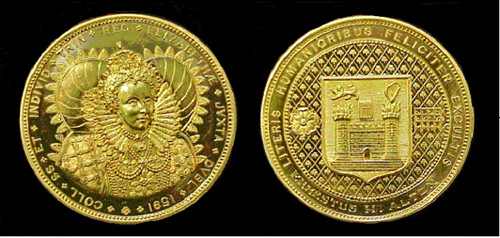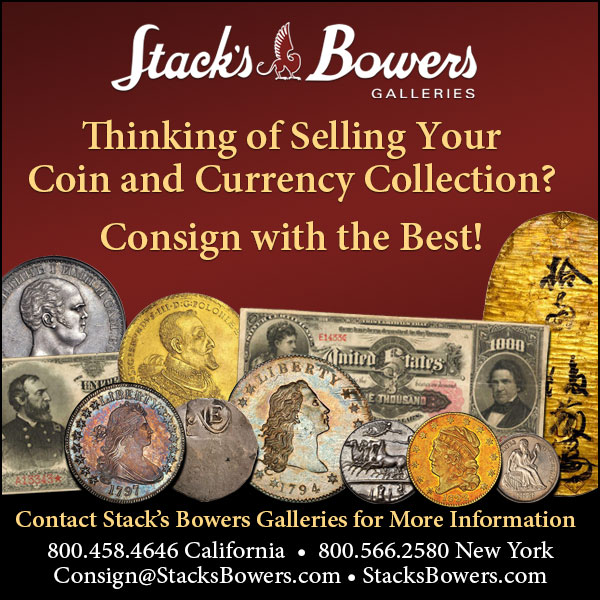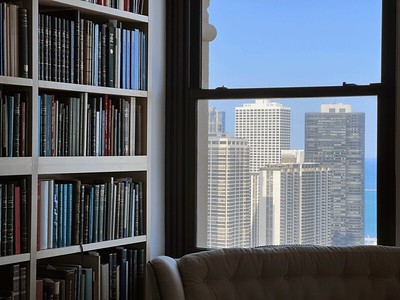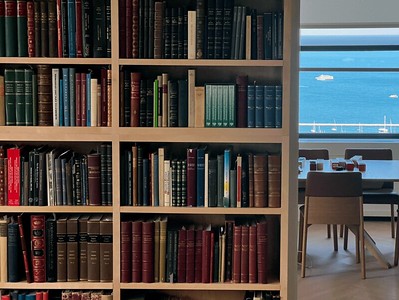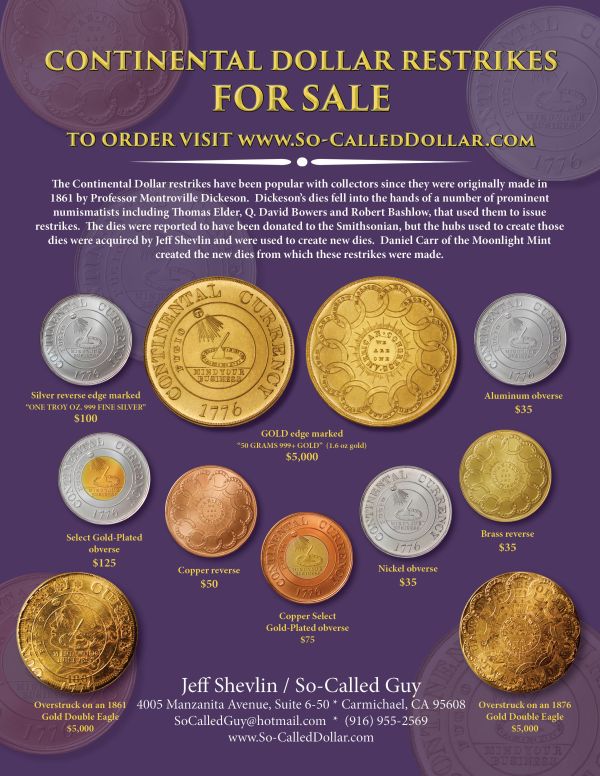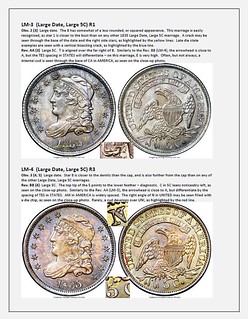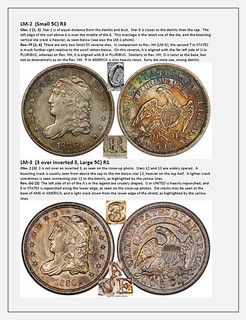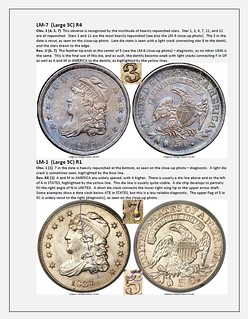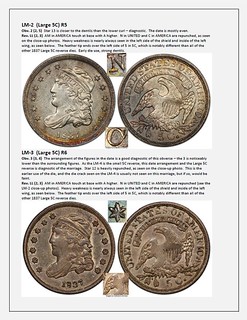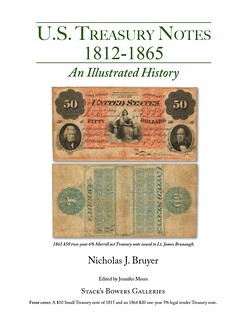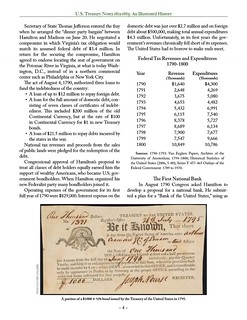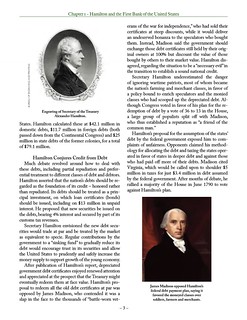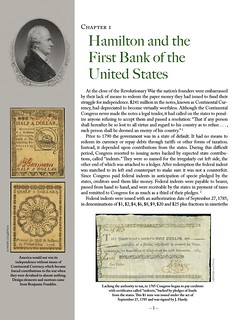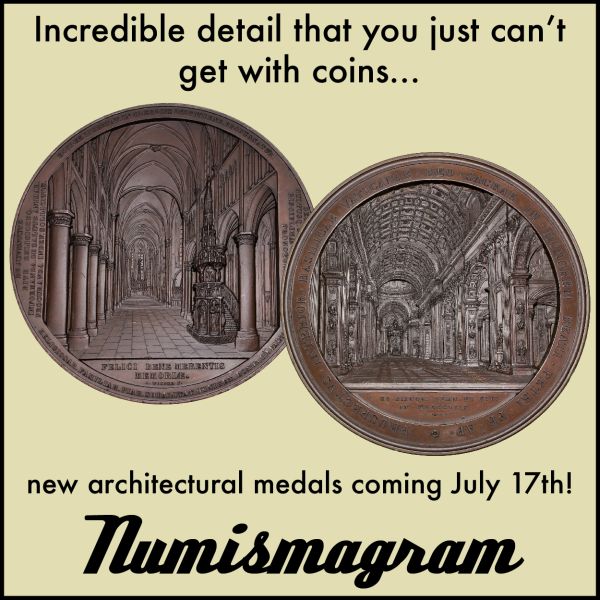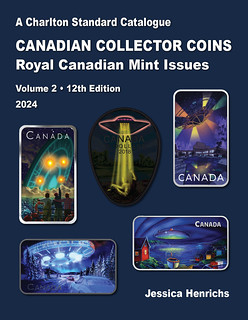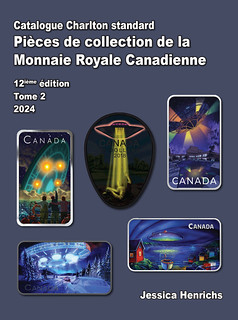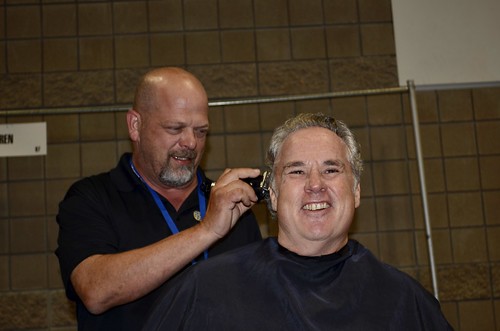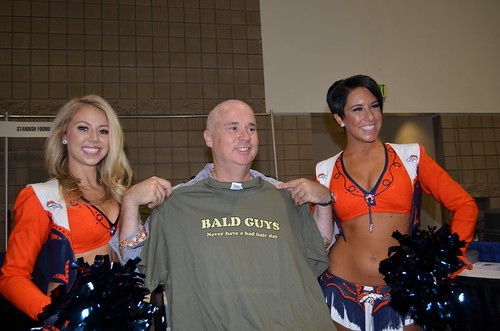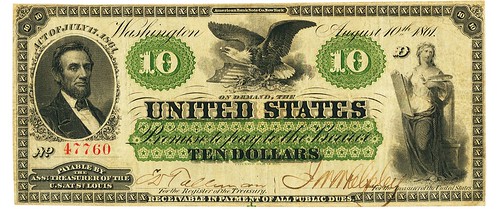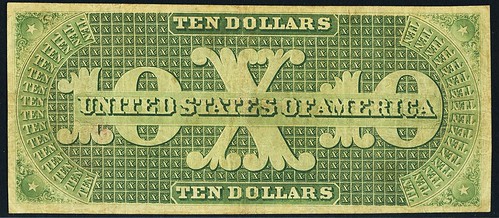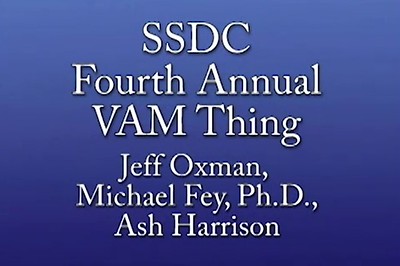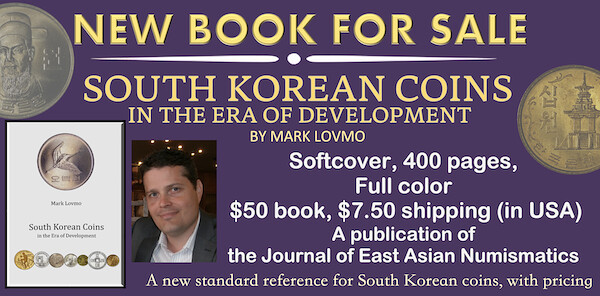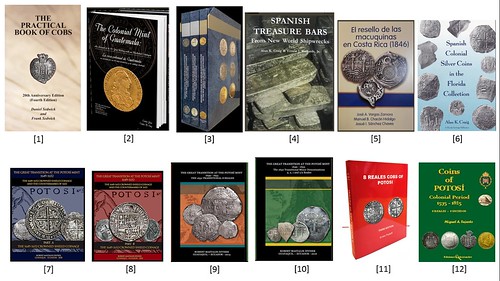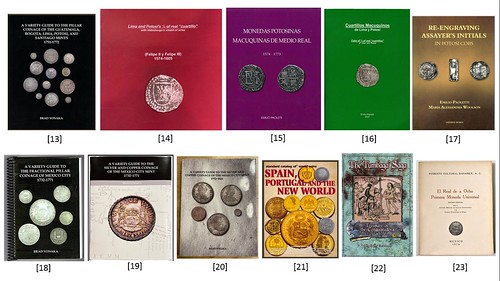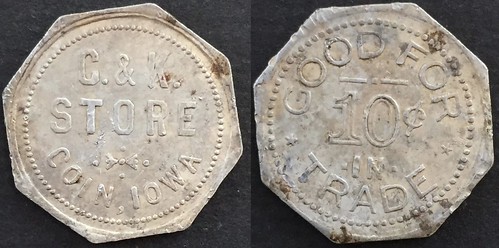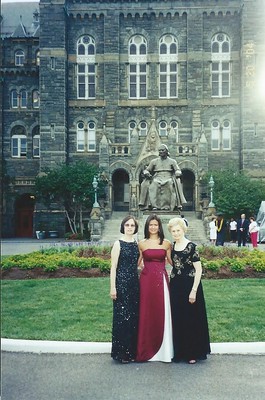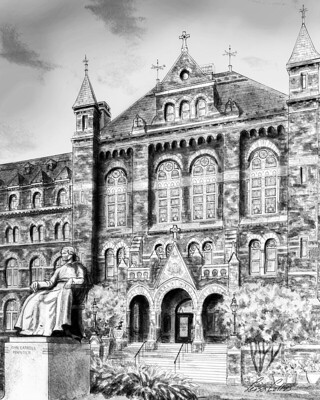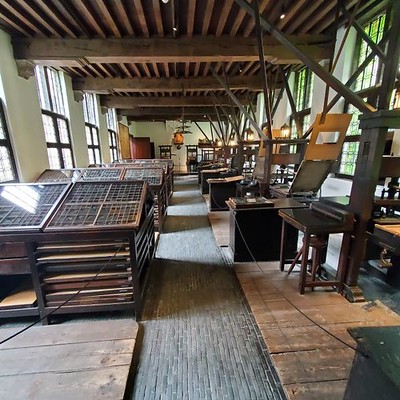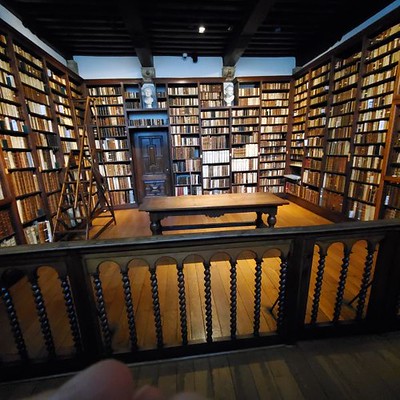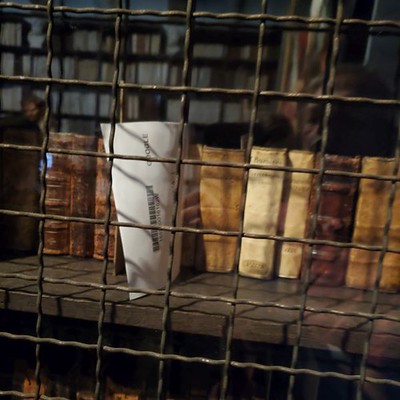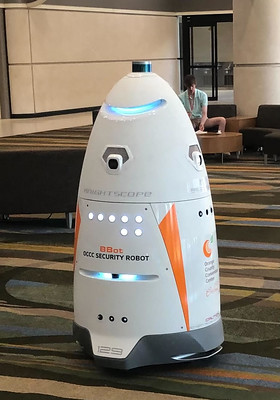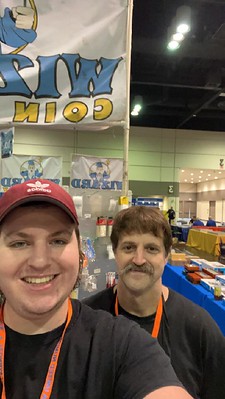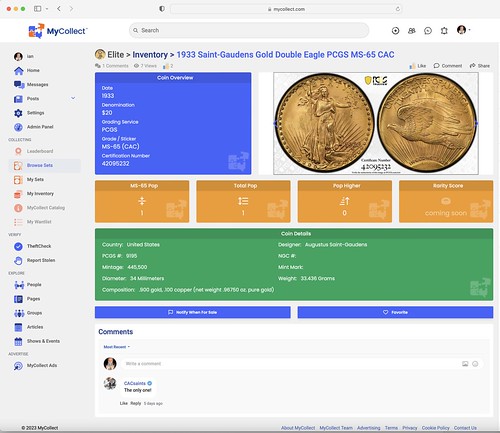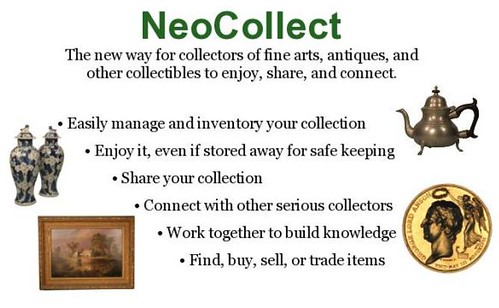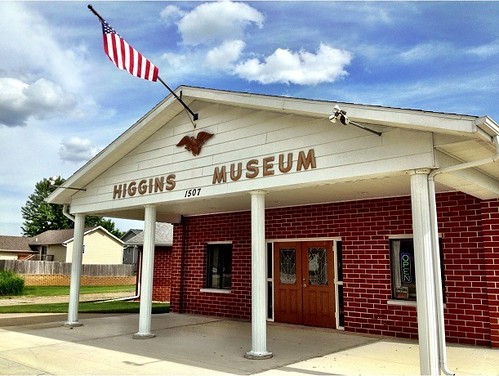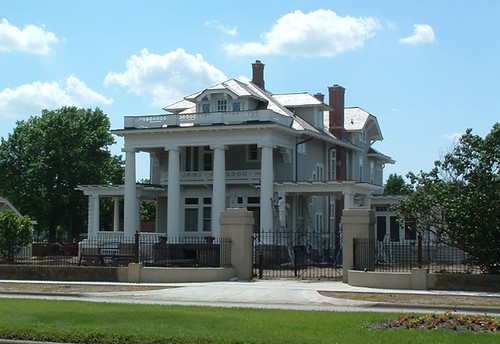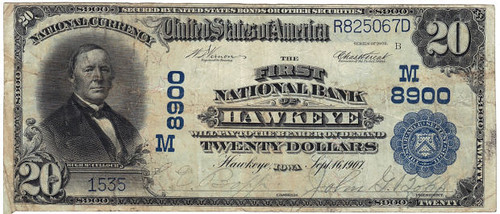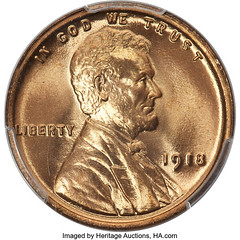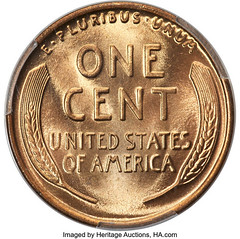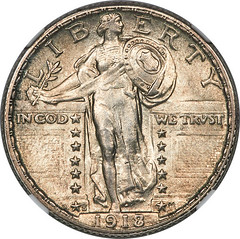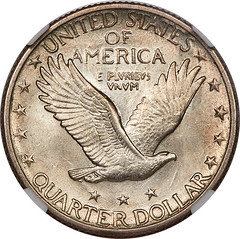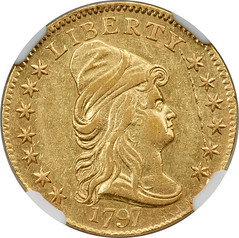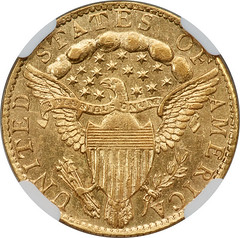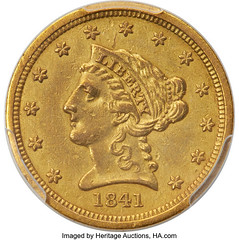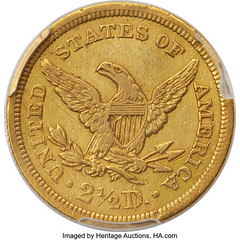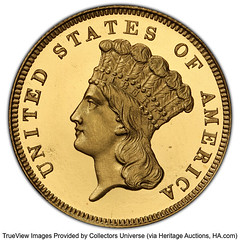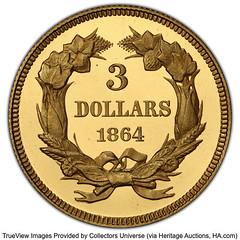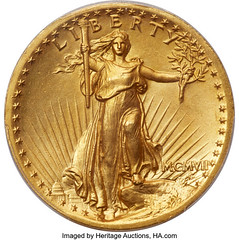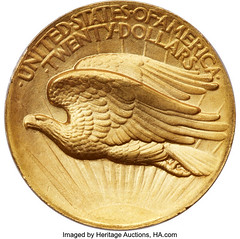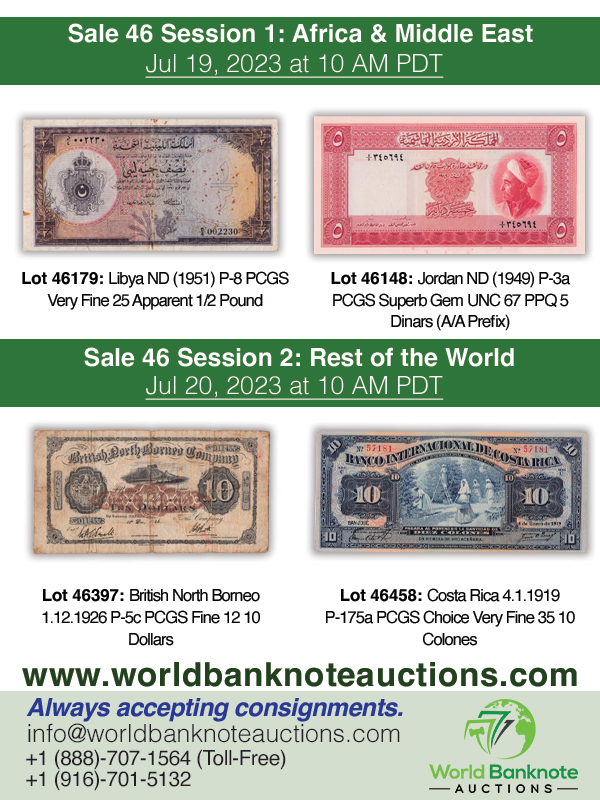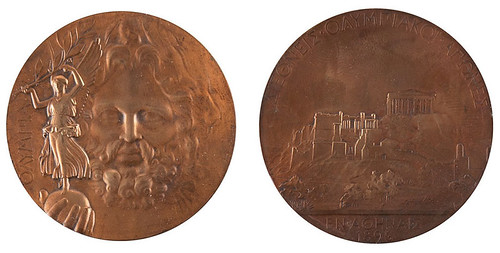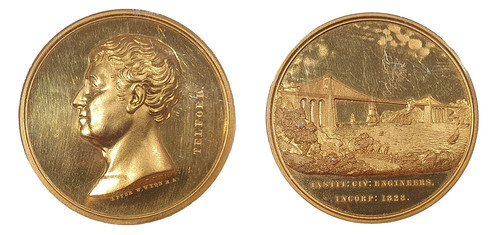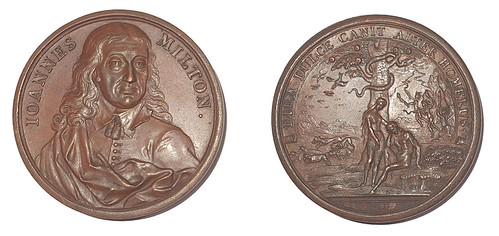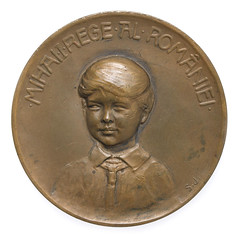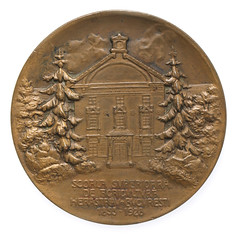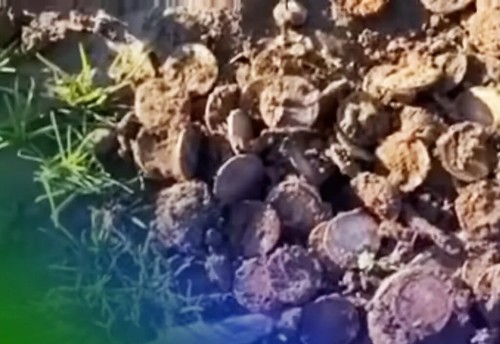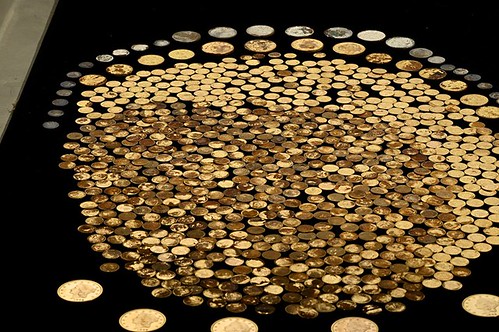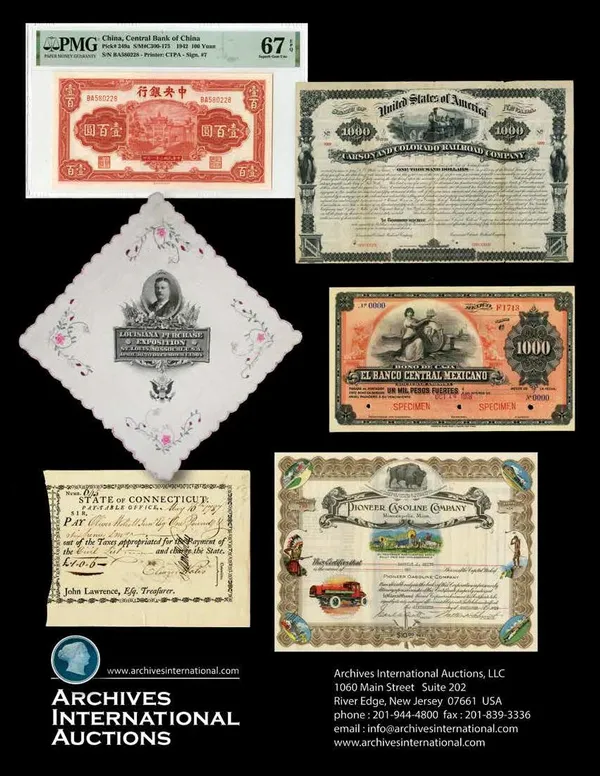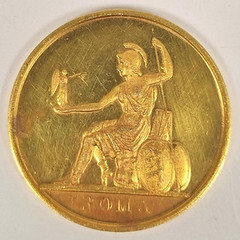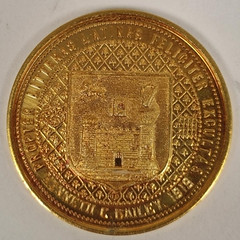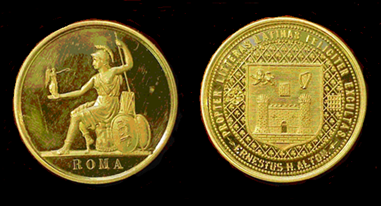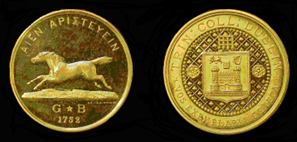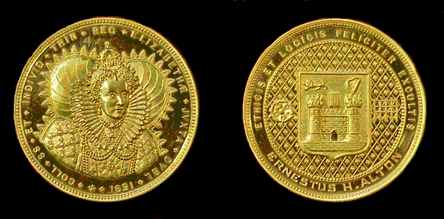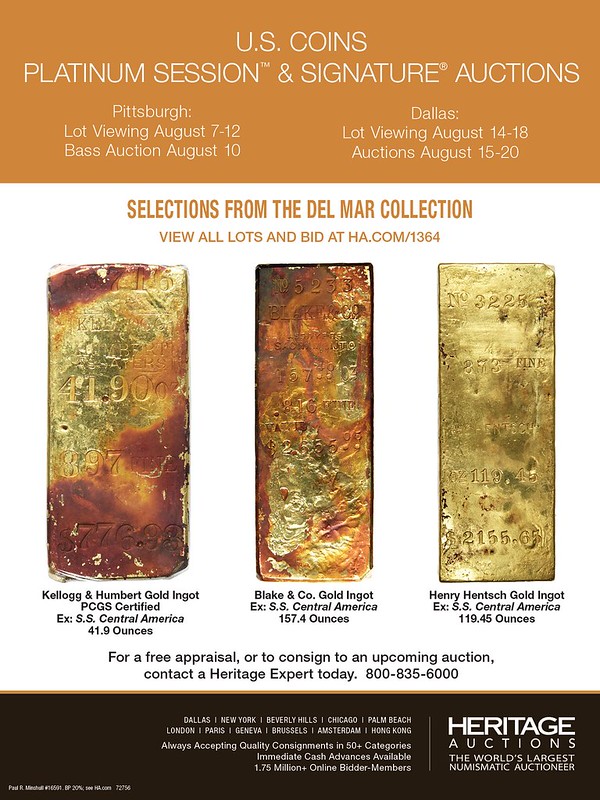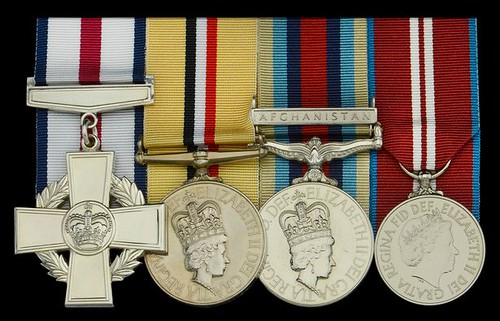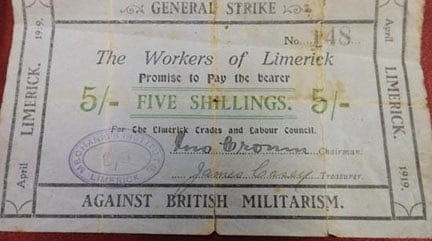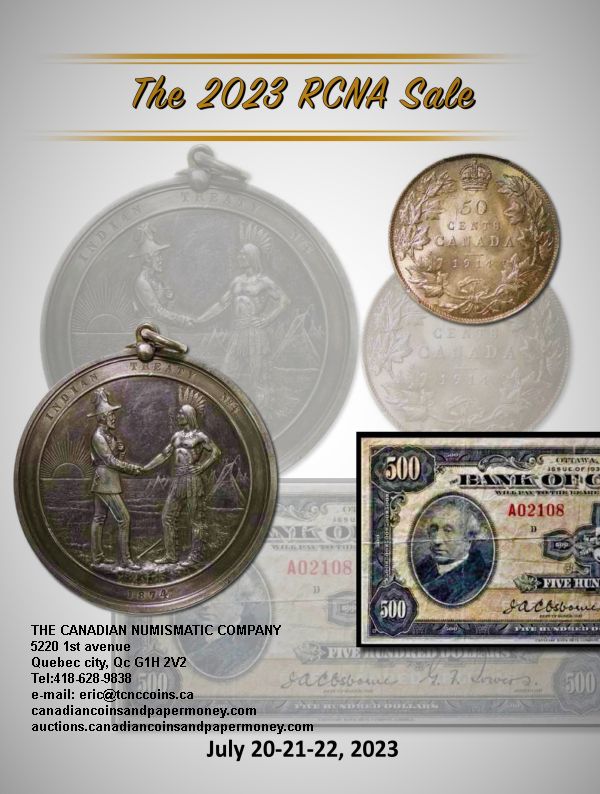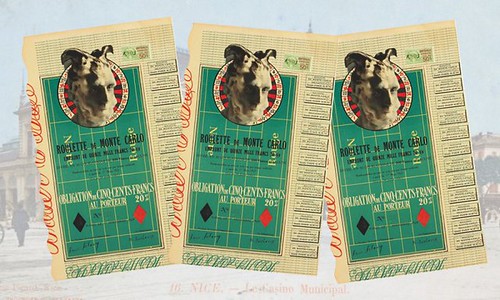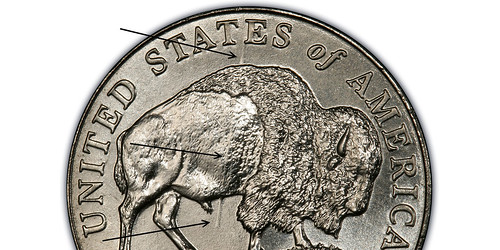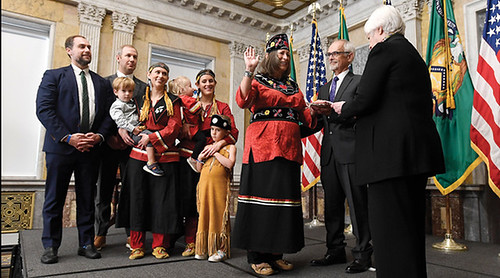
Visit our NBS Sponsors




About UsThe Numismatic Bibliomania Society is a non-profit association devoted to the study and enjoyment of numismatic literature. For more information please see our web site at coinbooks.org SubscriptionsThose wishing to become new E-Sylum subscribers (or wishing to Unsubscribe) can go to the following web page link MembershipThere is a membership application available on the web site Membership Application To join, print the application and return it with your check to the address printed on the application. Print/Digital membership is $40 to addresses in the U.S., and $60 elsewhere. A digital-only membership is available for $25. For those without web access, write to: Charles Heck, Treasurer AsylumFor Asylum mailing address changes and other membership questions, contact Chuck at this email address: treasurer@coinbooks.org SubmissionsTo submit items for publication in The E-Sylum, write to the Editor at this address: whomren@gmail.com BUY THE BOOK BEFORE THE COINSale Calendar |
- WAYNE'S WORDS: THE E-SYLUM JULY 16, 2023
- NBS BOOKBINDING DEMO: BUCKRAM
- NBS EVENTS AT THE 2023 PITTSBURGH ANA
- NEW BOOK: U.S. HALF DIMES 1792-1837
- NEW BOOK: U.S. TREASURY NOTES, 1812-1865
- NEW BOOK: COAL MINE OBSOLETE NOTES AND SCRIP
- NEW BOOK: CANADIAN COLLECTOR COINS, VOL 2 12TH ED.
- EDWARD E. FRITZ JR. (1948-2023)
- MICHAEL
MILES
STANDISH (1964-2023) - NNP: A PAIR OF 1939 RADIO PRESENTATIONS
- VIDEO: MORGAN AND PEACE DOLLAR VARIETIES
- BOOKS ON EIGHT REALES
- NOTES FROM E-SYLUM READERS: JULY 16, 2023
- MYCOLLECT SOCIAL NETWORK LAUNCHED
- VOCABULARY TERM: NATIONAL MEDAL
- WILLIAM ROBERT HIGGINS, JR.
- HERITAGE JULY 2023 SELECTIONS
- RR AUCTION OFFERS OLYMPIC MEDALS
- NUMISMATIC NUGGETS: JULY 16, 2023
- MORE ON THE GREAT KENTUCKY HOARD
- THE TRINITY COLLEGE DUBLIN GOLD MEDAL
- CONSPICUOUS GALLANTRY CROSS OFFERED
- LIMERICK SOVIET BANK NOTE FOUND
- MARCEL DUCHAMP'S MONTE CARLO BOND
- LOOSE CHANGE: JULY 16, 2023
Click here to read the thin version on the web
Click here to subscribe
Click here to access the complete archive
To comment or submit articles, reply to whomren@gmail.com
Content presented in The E-Sylum is not necessarily researched or independently fact-checked, and views expressed do not necessarily represent those of the Numismatic Bibliomania Society.
WAYNE'S WORDS: THE E-SYLUM JULY 16, 2023
 New subscribers this week include:
Fred Peterson, courtesy Fred Liberatore.
Welcome aboard! We now have 8,067 subscribers.
New subscribers this week include:
Fred Peterson, courtesy Fred Liberatore.
Welcome aboard! We now have 8,067 subscribers.
Thank you for reading The E-Sylum. If you enjoy it, please send me the email addresses of friends you think may enjoy it as well and I'll send them a subscription. Contact me at whomren@gmail.com anytime regarding your subscription, or questions, comments or suggestions about our content.
This week we open with NBS events at the Pittsburgh ANA, four new books, two obituaries, updates from the Newman Numismatic Portal, and more.
Other topics this week include Half Dimes, U.S. Treasury Notes, Coal Mine scrip, numismatics on the radio, VAMs, National Medals, auction previews, Trinity College Dublin gold medals, Limerick Soviet notes, and Duchamp's Monte Carlo bonds.
To learn more about buckram bindings, Ed Fritz, "Miles" Standish, Spanish and South American Eight Reale coins, the Museum Plantin-Moretus, Wizard Coin Supply, the MyCollect social network, the Speared Bison Nickel, the founder of the Higgins National Bank Note Museum and The Man Who Makes the Money at the Mint, read on. Have a great week, everyone!
Wayne Homren
Editor, The E-Sylum
NBS BOOKBINDING DEMO: BUCKRAM
The Numismatic Bibliomania Society table at this summer's American Numismatic Association World's Fair of Money® will feature a special live bookbinding demonstration. Len Augsburger submitted this update. -Editor
NBS Bookbinding at the ANA Convention
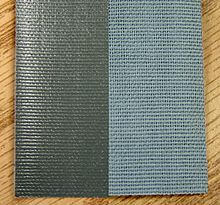 This week's bookbinding term is buckram. While sometimes not appearing as cloth, buckram covering is indeed cloth-based and has been soaked in a glue or starch solution in order to reinforce the overall binding. This makes the book more durable, and buckram binding is typically employed in public libraries, where usage may be higher than within a private library.
This week's bookbinding term is buckram. While sometimes not appearing as cloth, buckram covering is indeed cloth-based and has been soaked in a glue or starch solution in order to reinforce the overall binding. This makes the book more durable, and buckram binding is typically employed in public libraries, where usage may be higher than within a private library.
Illustrated here are examples of buckram cloth, with two different finishes. We'll be using a simpler treatment in our bookbinding demo at the ANA, with plain boards covered in marbled paper. In Tom Harrison's announcement of NBS events at the ANA, the identity of the book we are binding is revealed.
To read the earlier E-Sylum articles, see:
NBS BOOKBINDING DEMO AT THE ANA
(https://www.coinbooks.org/v26/esylum_v26n25a02.html)
NBS BOOKBINDING DEMO: CURVED NEEDLE
(https://www.coinbooks.org/v26/esylum_v26n26a02.html)
NBS BOOKBINDING DEMO: AWL
(https://www.coinbooks.org/v26/esylum_v26n27a02.html)
BOOKBINDERS UNITE AT THE ANA CONVENTION
(https://www.coinbooks.org/v26/esylum_v26n28a02.html)
NBS EVENTS AT THE 2023 PITTSBURGH ANA
Time to get ready for numismatic bibliophile events at next month's American Numismatic Association show in Pittsburgh. -Editor
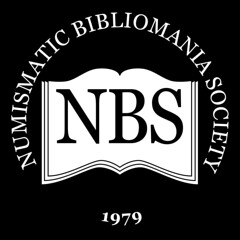 With the 2023 ANA World's Fair of Money in Pittsburgh only weeks away I wanted to
share some highlights of the Numismatic Bibliomania Society's events. From Tuesday through
Friday the NBS will host our club table (#433) located near literature dealers Charles Davis and
Kolbe & Fanning. The table will provide an opportunity to receive a commemorative NBS coffee
mug with a $25 donation and view highlights from Friday's charity auction. Please be sure to
stop by on Wednesday, August 9th for a special book binding demonstration. Members will be
able to make their own updated The Asylum index for vols. 31-40 (2013-2022) that will take
about 45 minutes. Copies of the book will be made available to all NBS members at a future
date. Like all of our gatherings, the table is a great chance to connect with old friends and meet
new literature enthusiasts.
With the 2023 ANA World's Fair of Money in Pittsburgh only weeks away I wanted to
share some highlights of the Numismatic Bibliomania Society's events. From Tuesday through
Friday the NBS will host our club table (#433) located near literature dealers Charles Davis and
Kolbe & Fanning. The table will provide an opportunity to receive a commemorative NBS coffee
mug with a $25 donation and view highlights from Friday's charity auction. Please be sure to
stop by on Wednesday, August 9th for a special book binding demonstration. Members will be
able to make their own updated The Asylum index for vols. 31-40 (2013-2022) that will take
about 45 minutes. Copies of the book will be made available to all NBS members at a future
date. Like all of our gatherings, the table is a great chance to connect with old friends and meet
new literature enthusiasts.
The NBS Symposium will be on Thursday, August 10th at 1:00 in room 328. We are delighted to have researcher and author Dr. Harry Salyards sharing insights into his monumental book Eagle Poised On A Bank Of Clouds : The United States Silver Dollars Of 1795-1798. Prior to the Symposium the Board will conduct their annual meeting at 11:30 in room 328.
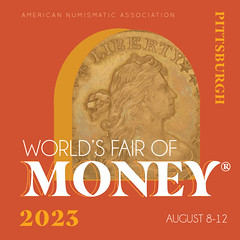 The General Meeting will be on Friday, August 11th at 11:30 in room 325. The meeting
will feature the presentation of The Asylum author awards, a video tour of the amazing library at
NBS Board member Shanna Schmidt's office, and our all-important charity auction. Again this
year we would like to invite attendees to bring a rare, obscure or whimsical item or two to share
during an informal fellowship time at the conclusion of official business. This will be an
opportunity to share a special item from your library and connect with fellow bibliophiles.
The General Meeting will be on Friday, August 11th at 11:30 in room 325. The meeting
will feature the presentation of The Asylum author awards, a video tour of the amazing library at
NBS Board member Shanna Schmidt's office, and our all-important charity auction. Again this
year we would like to invite attendees to bring a rare, obscure or whimsical item or two to share
during an informal fellowship time at the conclusion of official business. This will be an
opportunity to share a special item from your library and connect with fellow bibliophiles.
We hope many of you will be able to attend our events and help support the mission of the NBS.
I missed the convention last year due to a conflict with our daughter's college move-in date, but I'm looking forward to the 2023 show in my hometown of Pittsburgh. I plan to be at all of the NBS events as well as the NBS table, and hope to see many of our readers throughout the week.
As a teaser for the General Meeting program, here are some views of Shanna's library from her email Newsletter #206, published on Friday July 14. -Editor
For more information on the ANA event, see:
https://www.money.org/worldsfairofmoney/
NEW BOOK: U.S. HALF DIMES 1792-1837
Robert Powers has published the latest book in his series of variety & die state attribution guides. -Editor
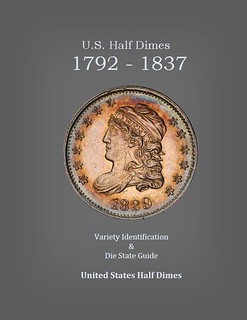 Proudly presented to you is the 7th publication of a series of variety identification guides covering Early U.S. Coins. This book covers all of the currently known die marriages of the U.S. Half Dimes series from 1792-1837, including the newly discovered marriages not covered by any other guide. A complete list of all of the author's previous publications to date are below, which are highly recommended:
Proudly presented to you is the 7th publication of a series of variety identification guides covering Early U.S. Coins. This book covers all of the currently known die marriages of the U.S. Half Dimes series from 1792-1837, including the newly discovered marriages not covered by any other guide. A complete list of all of the author's previous publications to date are below, which are highly recommended:
1. U.S. Large Cents 1793-1814 (Early Date Large Cents)
2. U.S. Large Cents 1816-1839 (Middle Date Large Cents)
3. U.S. Half Cents 1793-1857 (Complete Series)
4. U.S. Half Dollars 1794-1807 (Flowing Hair and Draped Bust)
5. U.S. Half Dollars 1807-1826 (Capped Bust Halves, Vol. 1)
6. U.S. Half Dollars 1827-1836 (Capped Bust Halves, Vol. 2)
7. U.S. Half Dimes 1792-1837 (Flowing Hair, Draped, and Capped Bust)
The primary focus of this guide is to have you quickly and efficiently attributing your Flowing Hair, Draped Bust, and Capped Bust Half Dimes. That used to be no easy task, but we've made it far easier than ever before with our down-to-Earth system focusing on naked eye observations (photo memory recall), dentil alignments, close-up photos, as well as clearly illustrated die cracks which we have augmented with lines drawn in order to make them easy to see. The large, full color, modern, ultra-high resolution photos found within were carefully selected for these purposes.
The author of this book has had a strong interest in Early U.S. coins for over 30 years. He set out to write this series of books because he has wanted to read them for many years, and finally gave up on waiting for someone else to write them.
Good luck!
For more information, or to order, see:
U.S. Half Dimes 1792-1837 Variety Identification Guide, by Robert Powers
(https://www.davidkahnrarecoins.com/u-s-half-dimes-1792-1837-variety-identification-guide-by-robert-powers.html)
NEW BOOK: U.S. TREASURY NOTES, 1812-1865
Stack's Bowers has published a new book by Nicholas J. Bruyer on an important, underappreciated topic, U.S. Treasury Notes. With permission, here are a couple excerpts from the book. I don't have ordering information at this time, however. -Editor
U.S. Treasury Notes, 1812-1865: An Illustrated History
by Nicholas J. Bruyer
First, here's a section from the Foreword by Stack's Bowers Galleries Director of Currency Peter A. Treglia. -Editor
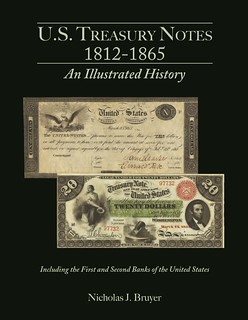 In U.S. Treasury Notes 1812-1865 we are presented
for the first time with a coherent and chronologically
ordered book on early United States paper money,
featuring an abundance of high-quality illustrations
of notes from this era, alongside their historical correlations. It provides an in-depth understanding of why
many of these banknotes were initially issued, whether
to finance wars or to salvage the United States from
imminent collapse. The lack of information concerning Treasury notes has long been acknowledged, but
now collectors can approach them with confidence,
armed with newfound knowledge of their history and
significance to our nation's monetary system.
In U.S. Treasury Notes 1812-1865 we are presented
for the first time with a coherent and chronologically
ordered book on early United States paper money,
featuring an abundance of high-quality illustrations
of notes from this era, alongside their historical correlations. It provides an in-depth understanding of why
many of these banknotes were initially issued, whether
to finance wars or to salvage the United States from
imminent collapse. The lack of information concerning Treasury notes has long been acknowledged, but
now collectors can approach them with confidence,
armed with newfound knowledge of their history and
significance to our nation's monetary system.
This isn't just an important reference; it's also written in a concise and enjoyable way that fills a gap in the numismatic library. Tracing these issues from the First Bank of the United States to the War of 1812, the Panics of 1837 and 1857, and Interest Bearing Treasury Notes during the Civil War, Nick's chronicle provides historical context through a good story, solid research, and representative images.
This book explains how these banknotes evolved over time, why they were issued, and how they were distributed, alongside a comprehensive summary of the historical events related to their issuance. Among the highlights is extensive research on Treasury ledgers, important figures in politics and finance, different interest types, what the funds were used for, and other fascinating details. Many of the notes illustrated in the book are rare proofs or specimens, some of which were never issued or are unknown in their issued form. In the past, this has resulted in the dearth of general information and available illustrations, but Nick has tackled this daunting project with enthusiasm, integ.rity, and a deep understanding of financial history.
Here's a section from the author's Introduction. -Editor
One note in particular jumped out at me – a $50 1861 two-year 6%
Treasury note payable to Jas. Brunaugh.
Digging
into the standard references on U.S. currency revealed
little about it.
Received wisdom held that these notes were originally sold at a discount to face value, mostly to banks, and were not used in commerce. Upon researching the mysterious Mr. Brunaugh, I was surprised to learn that he was neither an investor nor a banker, but a U.S. army lieutenant in an Iowa volunteer regiment, whose job as quartermaster was to clothe, arm and feed them. The Treasury Department had issued a packet of these notes in $50 and $100 denominations, undiscounted at full face value, to Lt. Brunaugh for supplies.
As I explored the story of these notes in contemporary press accounts I discovered Secretary of the Treasury Salmon P. Chase used them for all manner of payments, from warships to Congressional salaries. Turning next to Donald Kagin's fine book on Treasury notes from the War of 1812, it was clear that Treasury Secretary Alexander Dallas took great, albeit flawed, measures to establish Treasury notes as a circulating medium. Digging deeper into other issues – the Panic of 1837, the Mexican War, the Panic of 1857 – revealed Treasury notes bearing nominal interest (as little as one mill percent) used as money to buy goods and services.
At the nation's most desperate moments – when
federal depositories were emptied, when mountains
of creditor bills piled up for months, when armies in
the field went unpaid, when fearful bankers refused to
loan the government a dime – time and again Congress and the Treasury Department turned to Treasury
notes to rescue their administrations from insolvency.
Some say that an interest-bearing certificate cannot
be money, yet 6% compound interest Treasury notes,
which were the U.S. government's go to
currency
from June 1864 through the end of the Civil War,
refute this. Moreover, I found nothing to support the
claim that the government sold Treasury notes below
face value.
No doubt large amounts of Treasury notes were sold to investors, sometimes at a premium to face value, and were held as investments until maturity. In some instances, such as the two-year Treasury notes of 1847, there is no evidence that any of them were used as money. Yet history amply reveals that secretaries of the Treasury, as well as Congress itself, purposely and repeatedly imbued Treasury notes with features necessary for them to be used commercially as money.
NEW BOOK: COAL MINE OBSOLETE NOTES AND SCRIP
Dave Schenkman has published his long-awaited new book on Coal Mine scrip! -Editor
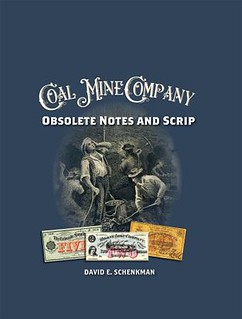 Coal Mine Company Obsolete Notes and Scrip
Coal Mine Company Obsolete Notes and Scrip
by David E. Schenkman
Binding: Hardcover
Edition: 1st
Publication Date: August 2023
Size: 8.5x11
Pages: 160
ISBN 13: 9798218956301
Price: $39.95
David Schenkman's highly anticipated book, Coal Mine Company Obsolete Notes and Scrip, is available for pre-order. The 160-page reference surveys over 600 notes, nearly 250 of which are depicted in full color.
Schenkman provided a rarity rating for each note, along with historical details about the note-issuing companies. Published by the National Scrip Collectors' Association, the volume is available for $39.95, and orders can be placed through Wizard Coin Supply's website (wizardcoinsupply.com) or by phone at 703-738-4485.
About the Author:
Schenkman began collecting coins in 1949, and began his interest in tokens and medals in 1960. From 1975 to 1980 he was editor of the Copperhead Courier, and he edited "A Survey of American Trade Tokens" in 1975. He authored World of Exonumia
in Coin World between 1985 and 1988 and Token Topics
in Numismatic News. He currently writes the "Tokens and Medals" column for The Numismatist. Schenkman has received more than seventy awards, including seven Heath Literary Awards. Over his career he has written ten books. In 2013, he received the Farran Zerbe Memorial Award from the American Numismatic Association, and he was inducted into the ANA Hall of Fame in 2015. Schenkman served as President of both the Token and Medal Society and the Civil War Token Society, and spent over 18 years as an instructor at the American Numismatic Association's Summer Seminar.
For more information, or to order, see:
Coal Mine Company Obsolete Notes and Scrip
(https://www.wizardcoinsupply.com/coal-mine-company-obsolete-notes-and-scrip)
NEW BOOK: CANADIAN COLLECTOR COINS, VOL 2 12TH ED.
There's a new edition of the Charlton Canadian Collector Coins catalog. -Editor
Charlton 2023-2024 Canadian Collector Coins catalogue — Royal Canadian Mint issues
$49.95
Canadian Collector Coins, Royal Canadian Mint Issues, Volume 2, 12th Edition, 2023-2024. Available in English and French
The 12th edition, Volume Two is the leading authoritative catalogue on the Royal Canadian Mint collector issues on the market today.
The Charlton catalogue references virtually all of the non-circulating legal tender issues ever released by the Royal Canadian Mint since the 1950s!
This issue lists all original issue prices, current trend values, specifications, designers' and engravers' information.
The 2023 edition features more than 2,200 coin designs and contains 3,000+ colour illustrations, covering all Royal Canadian Mint releases from 1954 to 2022.
The 12th Edition is a must for the collector tracking mint and bullion issues.
Format: 7 x 9
Pages: 640
Binding: Spiral
English version is spiral bound and the French version is perfect bound
For more information, or to order, see:
Charlton 2023-2024 Canadian Collector Coins catalogue — Royal Canadian Mint issues
(https://coinstampsupplies.com/product/charlton-2023-2024-canadian-collector-coins-catalogue-royal-canadian-mint-issues/)
EDWARD E. FRITZ JR. (1948-2023)
Ohio dealer Ed Fritz has passed. He was an ANA Summer Seminar instructor, and his family has established the Edward E Fritz Young Numismatist Scholarship Fund. -Editor
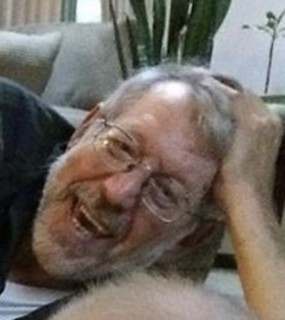 Edward E. "Ed" Fritz, Jr. age 74 of Lebanon, it is with deep sadness that we inform you of the passing of Edward E. Fritz, the founder of Centerville Coin & Jewelry. Ed was a remarkable individual known for his integrity and genuine character. His passion for collecting and numismatics was only surpassed by his unwavering care and concern for others. Ed's impact on the hobby and the people involved in it cannot be overstated. For over 50 years, Ed dedicated himself to educating consumers and collectors, playing a vital role in expanding the hobby. Many owe their professional success to the support and selfless advice he generously provided. Ed was a trusted friend in the numismatic industry, and his absence will be deeply felt.
Edward E. "Ed" Fritz, Jr. age 74 of Lebanon, it is with deep sadness that we inform you of the passing of Edward E. Fritz, the founder of Centerville Coin & Jewelry. Ed was a remarkable individual known for his integrity and genuine character. His passion for collecting and numismatics was only surpassed by his unwavering care and concern for others. Ed's impact on the hobby and the people involved in it cannot be overstated. For over 50 years, Ed dedicated himself to educating consumers and collectors, playing a vital role in expanding the hobby. Many owe their professional success to the support and selfless advice he generously provided. Ed was a trusted friend in the numismatic industry, and his absence will be deeply felt.
In his final days, he was surrounded by his loving family, peacefully passing away on the morning of June 27th, 2023.
He was born on October 12, 1948, in Dayton, OH, the son of the late Mary Elizabeth (Early) & Edward E. Fritz, Sr. Preceded in death by his brother Jim Lindsey, and by 2 sisters Judy Lindsey & Mary Robinson. He is survived by his loving wife of 54 years Shirley Ann (Huddleston) Fritz, his daughter Danielle Fritz and husband Thomas Brewster, 2 granddaughters December Ann Pergrem (Brannon), and Autumn Ellen Roadruck (Jeremy), 5 great grandchildren who he loved dearly...
A Gathering of Family & Friends will be held from 2:00 p.m. to 4:00 p.m. on Sunday, July 23, 2023, at the Swart Funeral Home, 207 E. Central Ave., West Carrollton. A Celebration of Life will be held on Thursday, July 27th at Third Eye Brewing prior to the Greater Cincinnati Coin Show between the hours of 7:00 pm to 9:00 pm, providing an opportunity for friends and acquaintances to pay their respects. The family is grateful for the prayers and support extended during this time of mourning. They earnestly hope that each person who had the privilege of knowing Ed will carry forward his legacy of kindness and caring in their interactions with others.
Ed was a former summer instructor at ANA Summer Session. To honor Ed's memory, his family is establishing the Edward E Fritz Young Numismatist Scholarship Fund. Each year, this scholarship will be awarded to a young numismatist between the ages of 8-21, with all the proceeds raised dedicated to supporting their education or entrepreneurial endeavors. By fostering the ongoing pursuit of knowledge among future generations of collectors and nurturing their passion for the hobby, this scholarship will carry forward Ed's legacy of learning. In lieu of flowers donations may be made to the Edward E Fritz Young Numismatist Scholarship Fund
https://gofund.me/648084a3
To read the complete obituary, see:
Edward Fritz Jr.
(https://www.legacy.com/us/obituaries/dayton/name/edward-fritz-obituary?id=52471017)
MICHAEL MILES
STANDISH (1964-2023)
Hobby figure Michael Miles
Standish has passed away unexpectedly at the age of 58.
-Editor
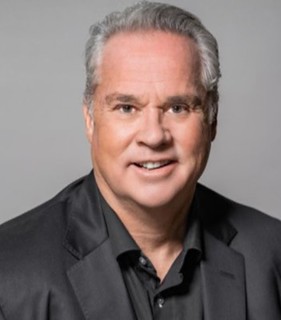 Michael Miles Standish, a renowned American businessman, author, numismatic specialist, and philanthropist, passed away unexpectedly at the age of 58 on Tuesday, July 11, 2023.
His tragic passing has left his community and loved ones heartbroken, as they mourn the loss of a remarkable individual who made a
lasting impact during his lifetime.
Michael Miles Standish, a renowned American businessman, author, numismatic specialist, and philanthropist, passed away unexpectedly at the age of 58 on Tuesday, July 11, 2023.
His tragic passing has left his community and loved ones heartbroken, as they mourn the loss of a remarkable individual who made a
lasting impact during his lifetime.
Michael Miles Standish was a highly respected figure in the world of rare coins, sports memorabilia, and philanthropy. He was a co-founder of Collectors Universe and served as the vice president of the Numismatic Guaranty Corporation at the time of his passing.
Standish's journey in the coin market began by attending coin exhibits in his local area. In 1984, he joined ANACS, America's Oldest
Grading Service, as a grader. During his time at ANACS, Standish wrote a monthly column titled Under the Loupe,
which was
published in Coin World from 1984 to 1988.
Born on November 13, 1964, in Kalamazoo, Michigan, Standish developed a passion for collecting coins and numismatic items at a young age. While attending Portage Central High School, he excelled in football and even worked as a disc jockey for the school's radio station. Standish's entrepreneurial spirit emerged early, as he began selling coins at the age of 17, setting up his first table at the National Silver Dollar Show in Houston, Texas, in 1982.
Michael Miles Standish leaves behind a legacy of expertise, passion, and philanthropy. His contributions to the world of numismatics and his dedication to improving the lives of those he encountered are deeply appreciated. The impact he made on the community and his vast knowledge will be greatly missed.
The obituary and funeral arrangements for Michael Miles Standish will be announced at a later date. As his community and loved ones mourn his untimely passing, they find solace in the memories of a man who made a significant difference in the numismatic world and touched the lives of many through his generosity and passion. May his legacy continue to inspire others to pursue their passions and contribute to making the world a better place.
To read the complete obituary, see:
Michael Miles Standish Obituary (1964-2023)
(https://www.interstim.net/michael-miles-standish-obituary-american-businessman-passed-away-at-58/)
Here's more from his Wikipedia page. -Editor
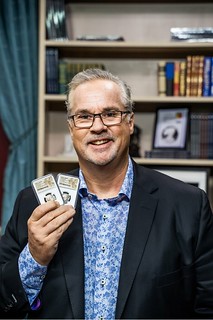 Standish is one of American numismatics' most recognized graders and authenticators of coins. Standish was the first full-time coin
grader at Professional Coin Grading Service. In the course of his career, Standish has graded between 8,000,000 and 10,000,000
coins, including a number of significant rarities, such as the 1913 Liberty nickels and all of the 1804 dollars.
Standish is one of American numismatics' most recognized graders and authenticators of coins. Standish was the first full-time coin
grader at Professional Coin Grading Service. In the course of his career, Standish has graded between 8,000,000 and 10,000,000
coins, including a number of significant rarities, such as the 1913 Liberty nickels and all of the 1804 dollars.
While with PCGS, Standish developed a number of marketing innovations, including PCGS' bulk submission and First Strike programs, the company's Signature Series of PCGS inserts which include autographs of notable figures such as Presidents George H. Bush and Gerald Ford, U.S. Mint Directors Donna Pope, Jay W. Johnson, and Philip Diehl, Edmund Moy, Chief Engraver John Mercanti, General Tommy Franks and Hall of Fame baseball player Nolan Ryan.
In 2011, for his service to numismatics and to the U.S. Mint, Standish was awarded the Director's Coin for Excellence
by
Director of the United States Mint, Edmund Moy.
Standish is an active participant in a non-profit organization that works with hospitals and healthcare providers to instill family and child friendly healthcare practices around the world. Standish's wife Andrea Mangione Standish is the founder and president.
Among many other awards and accomplishments, Standish has been awarded the honor of The commission of Kentucky Colonel. This is the highest title of honor bestowed by the Governor of Kentucky. It is recognition of an individual's noteworthy accomplishments and outstanding service to our community, state, and nation.
To read the complete article, see:
Michael "Miles" Standish
(https://en.wikipedia.org/wiki/Michael_%22Miles%22_Standish)
Hobby publicist and former American Numismatic Association Governor Donn Pearlman of Las Vegas, Nevada writes:
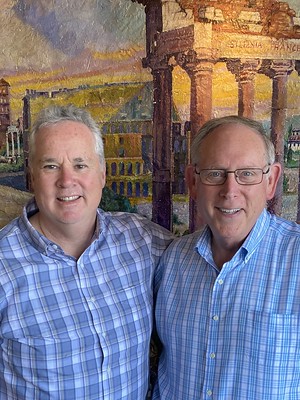 "I was stunned and deeply saddened when I learned that long-time numismatic friend and life-long Chicago Cubs fan Michael 'Miles' Standish passed away. My profound condolences to his wife, Andrea, and other family members and to his many friends worldwide. This photo was taken in May 2022 when Miles and Andrea joined me and my wife Fran for dinner in Las Vegas. [From left to right: Miles, Donn. -Editor]
"I was stunned and deeply saddened when I learned that long-time numismatic friend and life-long Chicago Cubs fan Michael 'Miles' Standish passed away. My profound condolences to his wife, Andrea, and other family members and to his many friends worldwide. This photo was taken in May 2022 when Miles and Andrea joined me and my wife Fran for dinner in Las Vegas. [From left to right: Miles, Donn. -Editor]
"My favorite memories of Miles involve the 'Shave Miles' charity fund-raiser at the American Numismatic Association 2017 Denver World's Fair of Money. Miles hired two Denver Broncos cheerleaders to be there. Pawn Stars TV show celebrity Rick Harrison made the first swipe of the clippers and several numismatic VIPs also took turns with the clippers. Immediately after the last bit of hair was removed, Miles held up a tee shirt I bought for him. It says, 'Bald guys never have a bad hair day.' Rest in peace, Miles."
Finally, here's a remembrance by Bob Evans. -Editor
Hooper.
I met Miles Standish in 2000 at PCGS. Miles was already familiar with me and my role in the discovery and recovery of the S.S. Central America treasure, from the pages of Gary Kinder's book, Ship of Gold: In the Deep Blue Sea. That book is based on a true story,
and most of what it relates about me rings true.
Within hours of our introduction Miles had settled in on a new moniker for me, Hooper,
based on the Richard Dreyfus character in Jaws. Nerdy, competent, fascinated by the science amid the drama and chaos; slowly gaining the respect of the working mariner; I suppose it fit, although it made me laugh. It wasn't just a one-time tease, and it persisted over the ensuing years. I have garnered many nicknames during my professional life, ranging from the almost pejorative Mudpie,
to the neutral but funny Little Gold Man,
to the undeservingly elevating Doctor Bob.
(Note: I am not a Doctor of any sort.) But this term of friendly endearment, Hooper,
was uniquely personal between Miles and me.
I would hear him call it out on bourse floors and hotel lobbies, at crowded receptions and at airports, delivered with a sing-song emphasis. I always, immediately knew that Miles had spotted me.
The last time was in the evening at the patio tables outside the Hilton in Rosemont, at last August's ANA. I was exhausted after a long day, and I was heading inside to my room to collapse. Then I heard, Hooper!
Responding to this call was a welcome obligation. He drew me into a brief discussion concerning my years-long project to write a book of my experiences, something I still plan to do. He expressed strong support for the idea. I thanked him for his vote of confidence, and then I took my leave since he had another guy at the table who didn't have the same familiarity with the SSCA or me.
I wonder if others received special nicknames from Miles. If so, then I feel I am part of an esteemed company. If not, then it is a singular honor.
Hooper
will miss him.
Thanks everyone. I didn't know Miles, but was quite sad to learn the news - another numismatist gone, and so young. -Editor
For more information, see:
https://www.facebook.com/donn.pearlman/posts/10223950036361573
Miles Standish, author and numismatist, dies at 58
(https://www.coinworld.com/news/us-coins/miles-standish-author-and-numismatist-dies-at-58)
RIP Miles Standish
(https://www.instagram.com/reel/CulEWD3gZ9M/)
NNP: A PAIR OF 1939 RADIO PRESENTATIONS
The latest addition to the Newman Numismatic Portal is a pair of 1939 radio scripts by Eric Newman. Project Coordinator Len Augsburger provided the following report. -Editor
A Pair of 1939 Radio Presentations
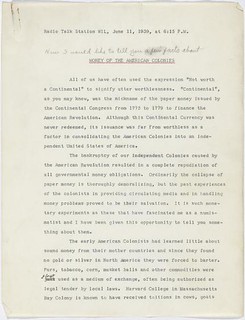 If someone talked about numismatics over the airwaves in 1939, what did they discuss? Remarkably, we can answer that question, at least in a couple cases. Recently located in the Eric P. Newman papers are scripts for two presentations delivered by Newman in 1939 over St. Louis radio station WIL (the call letters predated the standard K-format now used west of the Mississippi). The June 11, 1939 script provided an overview of colonial numismatics, while the August 13 presentation related to Newman's recently acquired 1861 St. Louis $10 demand note.
If someone talked about numismatics over the airwaves in 1939, what did they discuss? Remarkably, we can answer that question, at least in a couple cases. Recently located in the Eric P. Newman papers are scripts for two presentations delivered by Newman in 1939 over St. Louis radio station WIL (the call letters predated the standard K-format now used west of the Mississippi). The June 11, 1939 script provided an overview of colonial numismatics, while the August 13 presentation related to Newman's recently acquired 1861 St. Louis $10 demand note.
Newman purchased the 1861 demand note (then one of three known) from D.C. Wismer in July 1939 for $125. Wismer wrote to Newman on July 20: I do not believe you will ever regret buying the note… A wealthy Banker was the owner, and he told me he did not need the money, I was over six months trying to get it before I could get him to name a price, and after he named the price and I sent him my check he said he was sorry he sold it as he had intended to give it to his son.
This note later appeared in the Newman VIII sale (Heritage Auctions, November 2017), lot 28315, where it sold for $168,000. (For those scoring at home, the annual return was 9.7%.)
The Newman biographical papers, now at the Missouri History Museum Library in St. Louis, fill in the gaps leading up to the August 13 radio presentation. Newman, almost certainly referring to this $10 demand note, wrote to his then fiancée Evelyn Edison on August 2, 1939, Got 2 new Missouri banknotes which pleases me very much.
In further correspondence on August 4, Newman noted I am going to make another radio talk on August 13 of the same kind I made before but shorter. So come home & help me write it.
Images: St. Louis $10 Demand note (front), St. Louis $10 Demand note (back)
Andy Newman adds:
"Fascinating in several ways:
- Eric's making these 1939 broadcasts
- the contemporaneous details he provided in his letter to his fiancee
- the contemporaneous details Wismer provided in his note to Eric
- Eric's saving of all these documents
- Len's discovery of it all and putting the pieces together over 80 years later.
Link to Eric P. Newman 1939 radio presentations:
https://archive.org/details/Epn0930-1939wilradiopresentat
VIDEO: MORGAN AND PEACE DOLLAR VARIETIES
The David Lisot Video Library on the Newman Numismatic Portal can be found at:
https://nnp.wustl.edu/library/multimediadetail/522852
We highlight one of his videos each week in The E-Sylum. Here's one from 2007 with three panelists speaking about Morgan and Peace Dollar varieties (VAMs, for Van Allen-Mallis, authors of the key reference book on dollar varieties). -Editor
SSDC 4th Annual VAM Thing
The Society of Silver Dollar Collectors meeting is for those who specialize in Morgan and Peace Dollar varieties. The includes educational and VAM pricing information, the presentation of the VAM Master Award and other "goodies" guaranteed to entertain and inform those dollar collectors who just love those better dates and varieties as well as hearing about what is happening in the world of silver dollars. You will hear and learn:
-
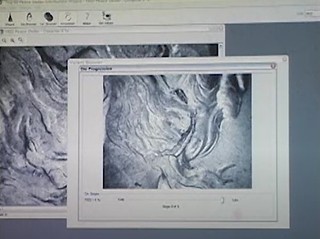 SSDC membership report
SSDC membership report
- introduction of officers and guests
- examples of Peace dollar varieties show progression die breaks
- Leroy Van Allen, his life story, and how VAM's came about
- examples of early publications about VAMS
- presentation of awards to SSDC membership
- other guest comments
Speaker(s): Jeff Oxman, Michael Fey, Ph.D., Ash Harrison.
To watch the complete video, see:
https://nnp.wustl.edu/library/book/560280
BOOKS ON EIGHT REALES
Recently Brad Porter asked for information on books about Spanish and South American 8 Reale coins. -Editor
Adrián González-Salinas of Monterrey, México writes:
"I want to share with The E-Sylum's readers a sample of Spanish Colonial Books that I could find."
Here's Adrián's handy list, along with the illustrations he provided. Wow - what a great compilation! Thank you for this! -Editor
- The Practical Book of Cobs (20th Anniversary) 4th Edition by Daniel Frank Sedwick (2007)
- The Colonial Mint of Guatemala: An Account of its 90-Year History with an Illustrated Catalogue by Carlos Jara & Carlos M. Paiz (2021).
- Spanish Colonial and Republican Cuartillos of the New World: A Detailed Catalogue (Volumes I, II and III) by Emilio Ortiz (2021).
- Spanish Treasure Bars From New World Shipwrecks by Alan K. Craig and Ernest J. Richards, Jr. (2003).
- El Resello de las Macuquinas en Costa Rica (1846) by José A. Vargas Zamora, Manuel B. Chacón Hidalgo & Josué I. Sánchez Chaves (2021).
- Spanish Colonial Silver Coins in the Florida Collection by Alan K. Craig (2000).
- The Great Transition at the Potosí Mint, 1649-1653: The 1649-1652 Crowned Shield Coinage and the Countermarks of 1652 - Part A: The 1649-1652 Crowned Shield Coinage by Robert Mastalir.
- The Great Transition at the Potosí Mint, 1649-1653: The 1649-1652 Crowned Shield Coinage and the Countermarks of 1652 - Part B: The Countermarks of 1652 by Robert Mastalir.
- The Great Transition at the Potosí Mint 1649 - 1653: The 1652 Transitional 8 Reales (2015) by Robert Mastalir
- The Great Transition at the Potosí Mint 1649 - 1653: The 1652 Transitional Minor Denominations 4, 2, 1 and 1/2 Reales by Robert Mastalir (2016).
- 8 Reales Cobs of Potosí - 3th Edition by Emilio Paoletti (2016).
- Coins of Potosí - Colonial Period 1575-1825 - 8 Reales . Escudos by Miguel A. Fajardo
- A Variety Guide to the Pillar Coinage of the Guatemala, Bogotá, Lima, Potosí, and Santiago Mints, 1751-1772, by Brad Yonaka (2018).
- Lima and Potosi's 1/4 of Real "Cuartillos" with Habsburgo's Shield of Arms - Felipe II y Felipe III (1574-1605) by Emilio Paoletti (2007).
- Monedas Potosinas Macuquinas de Medio Real 1574-1773 by Emilio Paoletti (2014).
- Cuartillos Macuquinos de Lima y Potosí by Emilio Paoletti (2007).
- Re-Engraving Assayer's Initials in Potosí Cobs by Emilio Paoletti and María Alessandra Woolson.
- A Variety Guide to the Fractional Pillar Coinage of Mexico City 1732-1771 by Brad Yonaka.
- A Variety Guide to the Silver and Copper Coinage of the Mexico City Mint 1732-1771 by Brad Yonaka (2021).
- A Variety Guide to the Silver and Copper Coinage of the Mexico City Mint, 1772-1821 by Brad Yonaka (2020).
- Spain, Portugal and the New World by Krause-Mishler (2002).
- The Tumbaga Saga: Treasure of the Conquistadors by Agustín A. García Barneche (2018).
- El Real de a Ocho - Primera Moneda Universal Fomento Cultural Banamex (1976).
Also, you can find several of Emilio Paoletti's e-books (including some of the above titles) here:
EMILIO PAOLETTI VIRTUAL LIBRARY
(https://ep.omeka.net/items/browse)
To read the earlier E-Sylum article, see:
NOTES FROM E-SYLUM READERS: JUNE 25, 2023 : Books on Eight Reales Sought
(https://www.coinbooks.org/v26/esylum_v26n26a10.html)
THE BOOK BAZARRE
NOTES FROM E-SYLUM READERS: JULY 16, 2023
Beate Rauch: Still With Us
Last week Phil Iversen added the name of Beate Rauch to our discussion of U.S. women coin dealers. "Beate was a well-known dealer in foreign currency and traveled to many shows and was involved with many numismatic organizations including the International Bank Note Society, the Society for International Numismatics, the Convention of International Numismatics, and the Society for Ancient Numismatics."
He also noted that she "... lived in Los Angeles before moving to Las Vegas where she lived with her husband, Hans, and have since both passed." -Editor
Daniel Demeo writes:
"I asked a friend about Beate Rauch, who said that he had talked with her a week or so ago."
Phil writes:
"It was my mistake in writing what I did. It was only Hans who passed away. My bad."
Sorry for the confusion. We're glad to hear that Beate is still with us. -Editor
To read the earlier E-Sylum article, see:
NOTES FROM E-SYLUM READERS: JULY 9, 2023 : Beate Rauch
(https://www.coinbooks.org/v26/esylum_v26n28a13.html)
More on Greg Lyon
In her email newsletter this week, Shanna Schmidt writes:
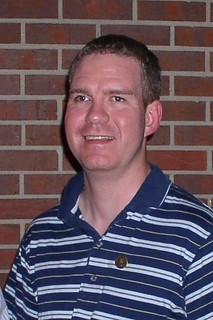 "It is with great sadness that my friend and former colleague on the ANA board, Greg Lyon, passed away on July 3rd. Greg was witty and smart as a whip. He might be the only person I know that actually was on the show Jeopardy with Alex Trebek. Not many people can put that on their resume! In addition to being a smartypants, Greg was dedicated like no other to the ANA. He was interested in coins from an early age and was extremely active in the YN program at the ANA.
"It is with great sadness that my friend and former colleague on the ANA board, Greg Lyon, passed away on July 3rd. Greg was witty and smart as a whip. He might be the only person I know that actually was on the show Jeopardy with Alex Trebek. Not many people can put that on their resume! In addition to being a smartypants, Greg was dedicated like no other to the ANA. He was interested in coins from an early age and was extremely active in the YN program at the ANA.
He also was Young Numismatist of the Year in 1989. He worked as a YN chaperone at the ANA summer seminar in Colorado Springs. Finally Greg served the maximum allowable terms as board governor and since we didn't want to lose him he accepted to be our parliamentarian when Mark Lighterman decided to run for the board. The ANA has set up a fund in Greg's honor for the YN program. Think about donating if you would like to donate to a cause that was dear to Greg's heart and also helps young people get involved in numismatics. Here is a link. Greg's fund is on the pull down menu under fund selection."
To read the earlier E-Sylum article, see:
GREG LYON (1971-2023)
(https://www.coinbooks.org/v26/esylum_v26n28a08.html)
A Coin, Iowa Token
Gawain O'Connor writes:
"I used to live in Iowa, and helped a bit with the token book. There are some tokens known from Coin, Iowa - here's one."
Cool - thanks! -Editor
To read the earlier E-Sylum article, see:
ANSWER: THE COIN SCHOOL
(https://www.coinbooks.org/v26/esylum_v26n28a18.html)
More on the Parents Magazine Medal
Scott Miller writes:
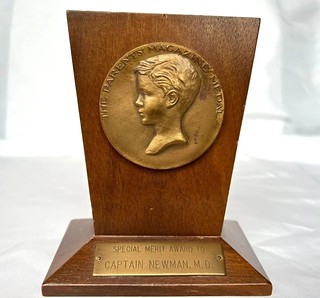 "Regarding the Parents' Magazine Medal, the Maco Specimen Archive at the American Numismatic Society attributes the medal to Jessie Willing with a date of 1928, and MACO number 1928-012. She was primarily an illustrator."
"Regarding the Parents' Magazine Medal, the Maco Specimen Archive at the American Numismatic Society attributes the medal to Jessie Willing with a date of 1928, and MACO number 1928-012. She was primarily an illustrator."
Thank you. -Editor
To read the earlier E-Sylum article, see:
: The Parents Magazine Medal
(https://www.coinbooks.org/v26/esylum_v26n28a23.html)
Mystery Photo Building and Statue Identified
Pete Smith was the first to identify the building in the mystery photo submitted by Shanna Schmidt and Len Augsburger. -Editor
"The mystery building in The E-Sylum last week is the Center on Faith and Justice at Georgetown University. Sorry, I cannot identify the women in the foreground."
Christopher Baker writes:
"A Google image search for the mystery photo reveals the location.
"John Carroll, Founder" statue before Healy Hall, Georgetown University, Washington, DC
https://d279m997dpfwgl.cloudfront.net/wp/2016/05/0502_georgetown-founder-1000x667.jpg
"Healy Building
https://en.wikipedia.org/wiki/Healy_Hall"
Robert Goler writes:
"The building is Healy Hall (Georgetown University). Appears to be a graduation day image with graduate, mother, and grandmother."
Hugh Cloke writes:
"The answer to this week's "Mystery Photo Assistance Sought" is Healy Hall, the main administration building at Georgetown University. The statue behind the three women in the photo is of John Carroll, the university's founder. I taught there for forty years."
B.J. Herbison writes:
"The only person I can identify is Bishop John Carroll who sat very still
for the picture.
https://en.wikipedia.org/wiki/Statue_of_John_Carroll"
So we still don't know the identities of the humans in the photo, but this is a start. Thanks also to Rob Luton, John Phipps, Sarah Miller of Heritage, David Sundman and Thomas Lovelace who all identified the building as well. -Editor
To read the earlier E-Sylum article, see:
NOTES FROM E-SYLUM READERS: JULY 9, 2023 : Mystery Photo Assistance Sought
(https://www.coinbooks.org/v26/esylum_v26n28a13.html)
The Man Who Makes the Money at the Mint
Nick Graver writes:
"I just re-discovered an item that has been here for years - sheet music in some form of Professional Copy from 1902.
"I'm the man who makes the money at the mint"
by Cobb and Edwards.
Copyright by F. A. Mills, NYC
I'd like to donate it to the NBS charity auction at the Pittsburgh ANA meeting. There must be a piano in the convention hall, and someone could play the music and sing the words, which are of quaint 1902 vintage."
Good times. Unfortunately, this missed the deadline for the 2023 auction, but cataloguer David Fanning will accept it for next year's sale. I looked online and couldn't find the lyrics or an image of the sheet, but did learn that Cobb and Edwards were big players in the music industry. Together they also wrote "The Medal and the Maid," perhaps another numismatic connection.
Gus Edwards was a vaudeville performer, wrote "By the Light of the Silvery Moon", was a founding member of ASCAP and was inducted into the Songwriters Hall of Fame in 1970. Bing Crosby played a fictionalized version of him in the 1939 film The Star Maker. -Editor
For more from Wikipedia, see:
https://en.wikipedia.org/wiki/Will_D._Cobb
https://en.wikipedia.org/wiki/Gus_Edwards_(vaudeville)
The Museum Plantin-Moretus
NBS webmaster Bruce Perdue is traveling, and sends this report that bibliophiles should appreciate.
He writes:
"Having a terrific time in Den Haag/The Netherlands. Went to Antwerp with my son and daughter on Wednesday. Visited the Museum Plantin-Moretus. A very impressive museum about publishing. I was especially impressed with the printing presses and the type foundry. They owned and caused to be created a huge variety of fonts, some of which are still in use today. I highly recommend it. I was offered an opportunity to print a document using a replica of the presses that are on display and found that quite interesting.
"The pressroom has the two oldest presses still in existence. The library is the personal library of the Moretus family.
Bruce adds:
"In a locked bookcase I noticed a small note that a book had been removed. I was surprised to see that it had been removed to be scanned by Google! All in all an impressive display of printing in the 1600-1800s and beyond."
Thank you - looks like a great museum. I've never been to the Netherlands, but we're starting to plan a European trip for next summer. This week our daughter and her friend managed to score floor tickets to the Taylor Swift concert - in Zurich. My wife and her friend's Mom (a neighbor of ours) are all going to the concert, with Dads and brothers in tow for the trip. I'm all ears for suggestions on things to see or places to stay in Zurich and nearby towns. -Editor
For more information, see:
WELCOME IN MUSEUM PLANTIN-MORETUS
(https://museumplantinmoretus.be/en)
FUN Fun
I wasn't at this week's FUN show, but here are a couple photos that came my way. -Editor
"Coin show security these days! R2-D2 style…"
The group had a good time with this - followup comments included
- "Can you order a cocktail through the thing? If not... what good is it?"
- "Our AI overlords are now here!"
- "Does it dispense cash?"
- "This isn't the droid I was looking for. (someone had to say it!)"
- "Reminds me of the cartoon showing two Daleks confronting a staircase - "This buggers up our plan for world domination!"
Collector Clutter Images Rating
Also on the Colonial Coins email list, people were discussing the Clutter Images Rating mentioend last week.
Craig McDonald writes:
"I reading this morning's E-Sylum, the last article talks about hoarding, and provides a link to a photo index rating of various levels of hoarding. Anyone want to fess up what their "coin room" looks like?
"I'll go first.....using the Living Room set of images, I'm about a 1.5 (my wife vehemently disagrees!), in that while I do have stuff, mostly catalogs and papers, piled on the floor and a chair, there is no clothing or garbage on the floor."
Other reader comments included:
-
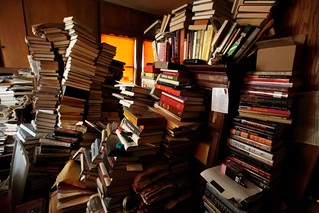 "That is absolutely hilarious… There's no way my wife would allow me to go outside my desk top which is a solid 5, complete with empty coffee mugs, coins boxes and catalogs! Scary stuff."
"That is absolutely hilarious… There's no way my wife would allow me to go outside my desk top which is a solid 5, complete with empty coffee mugs, coins boxes and catalogs! Scary stuff."
- "Wow, I may need to hire a librarian... I won't even go into the clutter numbers until I move aside some of these books. "
- "The number before or after my wife tells me to go through it and organize it all, LOL?"
- "Is there a category where you can't get in the room to take the photo?"
NOTE: the image is a stock photo. No actual coin books are buried in there, that I know of, anyway. -Editor
To read the earlier E-Sylum article, see:
LOOSE CHANGE: JULY 9, 2023 : The Clutter Image Rating
(https://www.coinbooks.org/v26/esylum_v26n28a27.html)
MYCOLLECT SOCIAL NETWORK LAUNCHED
This press release announces a new social network platform for coin collectors. -Editor
MyCollect™, a new social network for coin collectors has launched. Founded and operated by collectors and for collectors, it combines the best interactive features of the hobby and trade, such as informative message boards and set registries, but eliminates the algorithm problems often encountered with such platforms as Facebook.
The website (www.mycollect.com) is free of charge. Among the many features
are competitive sets of all U.S. coin series, the ability to post publicly or only privately to
selected friends, and TheftCheck™, the most extensive and timely searchable database
of stolen certified coins,
explained Ian Russell, founder of MyCollect and president of
GreatCollections in Irvine, California.
We have five enjoyable and educational goals for everyone in the hobby:
connecting, interacting, learning, collecting, and competing in a safe environment run by
collectors. Also, the registry section is not limited to one certification service, so
participants can add any or all of their PCGS, NGC, and CACG-certified coins to their
inventory and MyCollect Sets,
Russell stated.
This is going to be a game changer. MyCollect is going to be a great tool for
collectors and dealers alike,
stated Kenny Duncan, Jr., chief numismatist at U.S. Coins
and Jewelry in Houston, Texas who was given an early look at the platform.
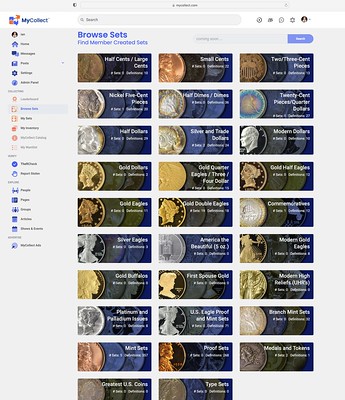 Within the first hours of operations on July 10, 2023, hundreds of accounts were
created and messages posted, and over $250 million in rare coins were added for
visitors to see in the MyCollect Sets section. The sets include the Elite Collection of
Saint-Gaudens Double Eagles featuring the world's most valuable rare coin, a 1933
Double Eagle that sold at auction for $18.9 million.
Within the first hours of operations on July 10, 2023, hundreds of accounts were
created and messages posted, and over $250 million in rare coins were added for
visitors to see in the MyCollect Sets section. The sets include the Elite Collection of
Saint-Gaudens Double Eagles featuring the world's most valuable rare coin, a 1933
Double Eagle that sold at auction for $18.9 million.
The big names like Facebook and Instagram are at a disadvantage as they do
not have vital coin or collectibles knowledge, and their frustrating algorithms are
criticized for not permitting users to always see all of their friends' posts in real time.
MyCollect is 100 percent owned and operated by collectors with the long-term vision to
help grow the hobby and marketplace. We have plans to add dozens of other
collectibles categories worldwide,
said Russell
One important feature, TheftCheck, is a tool the coin market has wanted and
needed for over a decade. By entering a PCGS, NGC, or CACG certification number,
you can instantly confirm if a coin has been reported stolen,
he explained.
The TheftCheck database is managed by former Texas Police Chief Doug Davis, founder of the Numismatic Crime Information Center. He will be entering theft reports on behalf of dealers, collectors, insurance companies, and law enforcement agencies.
In addition to collector user-friendly features, dealers and auction houses will be able to use the MyCollect and TheftCheck application programming interface (API).
It's been an immense amount of fun building MyCollect with our team. We
added features that help collectors and will continue to add more,
said Russell.
Visitors to the American Numismatic Association 2023 Pittsburgh World's Fair of Money® can see demonstrations of MyCollect at table 1200, August 8-12, in the David L. Lawrence Convention Center.
The first interview about MyCollect and demonstrations of the platform's many features were recently conducted in Houston, Texas for the Coin Shop Podcast hosted by Kenny Duncan, Jr. and Matthew Duncan.
For additional information, visit www.mycollect.com, phone 949-679-4180, or email info@mycollect.com.
This will be an interesting experiment. I don't collect slabbed coins myself, but most people do these days, and the uniformity and standardization provided by third-party grading services create a solid framework to build upon. The grading sites are like the Facebooks of the world, making it easy to get in, hard to get out, and impossible to reference or import data from or about competing grading services, as if they didn't exist. But they do exist and collectors need a universal platform encompassing all services.
Creating and maintaining an index mapping competing services onto a common framework is difficult and expensive - likely why it hasn't been done before. At the Newman Numismatic Portal we considered the idea but decided against it. Getting this right will be a key to MyCollect's success.
Another key is the "cold start" problem - new users want to dive right in. If there's "no there there" and the site looks like a ghost town, users get discouraged. Prepopulating collection information is a start. Users also don't want to have to manually enter countless items from their own collections, a data-entry nightmare. If they've already entered their data on other platforms, there needs to be an easy export/import feature. But as noted, other platforms aren't going to make that easy.
There have been multiple attempts at online systems for collectors, going all the way back to the CENTS system Joe Lepcyzk created on a mainframe computer back in the 1980s and John Sallay's NeoCollect in the 2000s. Perhaps this third try in the 2020s is a charm. -Editor
To read earlier E-Sylum articles, see:
NEW WEB SITE: NEOCOLLECT.COM
(https://www.coinbooks.org/esylum_v12n08a04.html)
To read earlier E-Sylum articles, see:
USER REVIEW: NEOCOLLECT.COM
(https://www.coinbooks.org/esylum_v12n14a16.html)
VOCABULARY TERM: NATIONAL MEDAL
Here's another entry from Dick Johnson's Encyclopedia of Coin and Medal Terminology. -Editor
National Medal.
A medal of national character or interest; a medal struck by a national mint. In the United States national medals
is a loose term for all the medals produced by the United States Mint at present, but only about half of those of the past. It includes all the medals authorized by U.S. Congress (congressional medals) plus all those sold to the public by the United States Mint (list medals). The term excludes private issue medals (once widely manufactured by the U.S. Mint but which have not been struck since 1956).
The term national medal has legal meaning in that it is mentioned in the United States Code (section 31, paragraph 368). This states that dies for national medals can be executed and the medals struck at the Mint with the approval of the Director, provided production of the medals do not interfere with the production of coins; further, no private dies can be made at the Mint, nor can the machinery in the Mint be used for private purpose.
Nineteenth century. The wording in the current Code is in stark contrast to the situation in the 19th century. For most nations early in their history, private medal presses with the capability to strike large medals just do not exist (it comes with a highly industrial development and a refined cultural need). In most countries the national mint is often the only source where large medals of artistic design can be produced. So it was in the United States as late as the 1890s.
Individuals, and organizations (both governmental and private), had to apply to the Philadelphia Mint as the only American maker of such medallic work. The only medals the U.S. Mint would not strike in the 19th century were political or campaign medals (although this rule was apparently broken for the Mint striking the Lincoln Cabinet Medal, PR-35, in 1964, and the John Charles Freemont Medal, PE-11, in 1863, which had been used during his presidential campaign of 1856). All campaign medals had to be struck by private medal makers. For the most part these were created by diesinkers who did not have presses of great capacity, thus most campaign medals were small diameter, token-like medals.
Left to their discretion, the directors of the mint were fairly liberal in allowing medals of any kind to be produced at the mint. Thus even wedding medals, Sunday school medals, parade medals, dog show and other ephemeral medals were struck at the national mint. These clients had to pay for the cost of making the dies, the blanking and striking, plus the cost of the metal composition (although they would sometimes furnish their own dies, or their own metal!).
About half of all the medals struck by the U.S. Mint from 1792 until 1900 could be considered personal or private, certainly not of a national character.
Whether any medal met the test of national interest was not required during most of the 19th century.
Twentieth century. Since 1892, and early in the 20th century, the rising infant medal industry sought out this business. Private American medal manufacturers grew in the 20th century until there existed ample production facilities available, eliminating the need for the U.S. Mint to strike such pieces.
Private medal manufacturers mounted their most aggressive campaign against the U.S. Mint for striking private medals during the depression in the mid 1930s. Orders had fallen until they had work for only half days. Despite this plea to get the mint out of the business which should have gone to private industry, the U.S. Mint continued.
It accepted private medal orders until 1948 but continued to strike those medals for which they had the dies. Only since 1950 has the definition of national medals been codified to eliminate the striking of personal and private medals by the U.S. Mint. The last such private medal was struck in 1956. See private issue.
References:
O37 {1977} Julian.
To read the complete entry on the Newman Numismatic Portal, see:
National Medal
(https://nnp.wustl.edu/library/dictionarydetail/516387)
WILLIAM ROBERT HIGGINS, JR.
E-Sylum Feature Writer and American Numismatic Biographies author Pete Smith submitted this article on the founder of the Higgins National Bank Note Museum. Thank you! -Editor
The origins of Bill Higgins are a bit cloudy, but still interesting. Although various records indicate he was adopted, the reason for the adoption is part of the mystery.
I will start the story with grandfather Hiram Higgins (1834-1906). He made a fortune as a grain dealer in Chicago and Burlington, Iowa, before retiring to Los Angeles. When he died, he left a complex will and trust with an estate worth about a half million dollars. He provided well for his widow, daughter and three grandchildren. He left a token amount to his son, William Robert Higgins (1862-1943) who had a strained relationship with his father. There were allegations of alcohol and drug abuse. William contested the will and the claim was settled by negotiations out of court.
William was a real estate investor with about ten thousand acres of Iowa farmland that provided rental income. In 1897 he married Bessie Carroll (1866-1961) with an ancestry that qualified her for the Daughters of the American Revolution and was a national officer with the D.A.R. The marriage was childless.
As the story goes, some time around 1917, an orphan train passed through Spencer, Iowa, and William and Bessie picked out a brother and sister. They named the boy William Robert Higgins, Jr. and the girl Elizabeth Carroll Higgins. By the 1920 Census, they were living with the family under those names.
The orphan train makes a good story but is probably not true. A 1915 Iowa Census lists William Junior living with William Senior.
Hennepin County (MN) birth records show William Robert Higgins, Jr. born in Minneapolis on April 14, 1913, with the mother's name as Carroll. William and Bessie owned the Adams-Higgins mansion on Grand Avenue in Spencer, Iowa. When they added children to the family in 1917, they also added a large 29 x 32 ft. playhouse behind the home. The mansion has recently been restored.
William and Bessie were divorced in 1928 with Bessie claiming cruel and inhuman treatment.
The divorce papers indicate this was his second marriage. After the divorce, the kids lived with
their mother. William married again in 1929 and was divorced again in 1933. While it may be
true that Junior came from a family of means, he was building on a shaky foundation.
William Jr. graduated from Drake University Law School in 1936 and was admitted to the bar in Iowa. In 1936, he was employed as a clerk with the Mason City office of state employment service. Published biographies do not mention that he practiced law.
While attending Drake, Higgins met a young radio announcer at WHO radio. Ronald Reagan would be a friend for sixty years.
In March of 1942, he joined the ANA as member 8950. In November 1945 he converted to life membership as LM 109.
He was stationed in China and the Pacific Theater as a First Sargent during World War II. He served with the 425th Bomber Squadron, 308 th Bomber Group. 14th Air Force under General Claire Chennault. While in China, he collected silver dollar sized coins wherever he could find them. He served as mayor of Okoboji, Iowa, from 1960 to 1974.
By 1973, he had formed a collection of 7000 crowns of the world. This was described as the largest private collection of crowns in the world. He consigned his collection to Jess Peters for a series of three auctions in 1973-74. The sales realized $1.2 million.
After 1972, he devoted himself to a collection of National Bank Notes of the 1863 to 1935 period. He travelled around Iowa visiting banks and looking for leads on notes he was missing. Out of 301 cities in Iowa that issued notes, he got examples of 278 of them. Promotional materials say he had 1902 red seal notes from fifty states and Puerto Rico. (I am skeptical about Hawaii!)
On September 26-28, 1975, Jess Peters conducted the sale of the Ray Byrne and William R. Higgins, Jr.
libraries. The sale was promoted as The Greatest Sale of Numismatic Literature ever held.
That might
make the basis for a good trivia question some day.
Higgins was unmarried and without children so he formed the William R. Higgins, Jr. Foundation and gave his collection to the people of Okoboji. Iowa, and the Higgins National Bank Note Museum.
As he formed the collection, Higgins did business through dealer John Thomas Hickman who became the first curator of the museum. The museum with 9000 square feet of space opened in 1978. One of the exhibits in the museum was a spider press on loan to the museum from the Bureau of Engraving and Printing. President Ronald Reagan assisted Higgins in arranging for the loan. At the end of the Reagan administration, the press was returned to the BEP. The museum purchased a smaller spider press that remains on exhibit.
The museum has National Bank Notes from around the country but the emphasis is on notes from Iowa. Other large exhibits are from neighboring states of Illinois, Minnesota, Missouri, Nebraska and South Dakota. Higgins did not collect notes from Wisconsin to avoid competition with a friend, Horace Monty Sherwin. Some Wisconsin notes have been added since the museum opened. The museum also has an extensive collection of Iowa picture postcards and a reference library.
The museum has conducted summer seminars on paper money topics intermittently since 1979.
Higgins was ill in his later years and died April 5, 1991, at Spirit Lake, Iowa. He is buried at Okoboji Cemetery. He was inducted into the Society of Paper Money Hall of Fame in 2015. The Higgins Museum in Okoboji. Iowa, is open in the summer from Memorial Day to Labor Day. Hours are 11:00 a.m. to 5:30 p.m. Tuesday through Sunday. Admission is free.
I encourage readers to visit. Say hello to the current curator, George Cuhaj! -Editor
To read earlier E-Sylum articles, see:
FEATURED WEB SITE: THE HIGGINS MUSEUM OF NATIONAL BANKNOTES
(https://www.coinbooks.org/esylum_v10n48a27.html)
VIDEO: THE HIGGINS MONEY MUSEUM
(https://www.coinbooks.org/v24/esylum_v24n29a07.html)
THE HIGGINS NATIONAL BANK NOTE MUSEUM
(https://www.coinbooks.org/v25/esylum_v25n42a11.html)
HIGGINS MUSEUM HIRES CUHAJ AS CURATOR
(https://www.coinbooks.org/v26/esylum_v26n11a06.html)
HERITAGE JULY 2023 SELECTIONS
Here are some U.S. selections from the Heritage July 20-23 Long Beach/Summer FUN Auction, starting with a condition rarity. -Editor
1918 1C MS68 Red PCGS. The 1918 Lincoln cent is common in most grades and boasts a mintage of more than 288 million coins. To the perception of most collectors, there is nothing remarkable about this issue. However, for the advanced Registry collector, the 1918 presents a significant challenge. Red Superb Gem examples -- all but essential for a high-ranking Registry Set -- are rare. Yet, for the most advanced and ambitious collectors, even most Superb Gems will not do. For the fortunate few, the finest examples of this date known are three MS68 Red coins certified by PCGS (6/23).
This coin represents the first appearance of an MS68 Red specimen in our auctions. Comparisons with even MS67 Red pieces that have come before is moot, since, in the world of Lincoln cents, there is a great expanse of rarity, value, and desirability between the two numerical points of MS67 and MS68. For collectors seeking the absolute finest quality, the 1918 is not a coin with a mintage of 288 million pieces; it is not a coin with a survivorship of tens of thousands; it is, rather, a coin with a population of three specimens.
To read the complete lot description, see:
1918 1C MS68 Red PCGS....
(https://coins.ha.com/itm/lincoln-cents/1918-1c-ms68-red-pcgs-pcgs-2506-/a/1362-3018.s)
1918/7-S 25C FS-101 MS64 Full Head NGC. By far, the 1918/7-S is the rarest issue in the Standing Liberty quarter series with Full Head designation. The FH population has gradually grown over the course of the last two decades or so as hidden pieces have made their way to the third-party graders, but the rate of new Full Head coin discoveries -- whether they be legitimate new discoveries or simply successfully upgraded non-Full Head pieces already known -- is glacially slow compared to the certification rate of other dates in the series. Moreover, the rarity of the overdate in Full Head is unlikely to ever be radically reduced by new certifications. This issue is inherently rare with Full Head detail.
To read the complete lot description, see:
1918/7-S 25C FS-101 MS64 Full Head NGC....
(https://coins.ha.com/itm/standing-liberty-quarters/1918-7-s-25c-fs-101-ms64-full-head-ngc-pcgs-395950-/a/1362-3051.s)
1797 $2 1/2 BD-1, High R.5, AU55 NGC. Bass-Dannreuther Die State b, the obverse is cracked from the Y in LIBERTY, down through the right obverse field to stars 12 and 13. The obverse crack is seen on all examples of this issue, with a single low-grade piece showing a large rim break covering most of the right-side stars.
Following the initial production of 66 quarter eagles that were delivered on September 21, 1796, mintages of this unwanted denomination remained small for many years. According to Mint records, fewer than 3,000 quarter eagles were coined during the first three years of the denomination, including 432 examples delivered on January 14, 1797, and a mere 427 coins delivered in three later batches in 1797. Today, we believe that the January delivery consisted of 1796 With Stars quarter eagles, and the later deliveries were coins dated 1797, though this is not absolutely certain.
Only a couple dozen of those 1797 quarter eagles exist today, according to John Dannreuther, who estimates that 20 to 25 pieces are extant in all grades. It is likely that the obverse die cracked during the hardening process before any coins were struck, and Mint employees had no opportunity to create a new die before the coins were produced. Accordingly, the obverse failed quickly. The reverse die was used to strike the JR-1 1798/7 dimes as well as this quarter eagle variety, apparently after the quarter eagles, as none are known with the later die states that the dimes show. We have listed the 10 finest coins known to us in the list of Significant Examples below.
To read the complete lot description, see:
1797 $2 1/2 BD-1, High R.5, AU55 NGC....
(https://coins.ha.com/itm/early-quarter-eagles/1797-2-1-2-bd-1-high-r5-au55-ngc-pcgs-45503-/a/1362-3177.s)
1841 $2 1/2 VF35 PCGS. Struck from the JD-1 proof dies (the only dies known), High R.6. The 1841 Liberty quarter eagle is one of the rarest and most enigmatic issues in the U.S. gold series. The 1841 Annual Report of the Director of the Mint does not list any quarter eagles produced at the Philadelphia Mint that year, but the coins have been known to exist since the time of issue. A specimen was placed in the Mint Cabinet in 1841 and Jacob Eckfeldt and William Dubois mentioned the issue, and provided an engraved image of an example, in their 1842 book A Manual of Gold and Silver Coins of All Nations. Mint Director James Ross Snowden also specifically mentioned the 1841 quarter eagle in his 1860 reference on the Mint Cabinet, but the issue seldom appeared at auction in the 19th century and little notice was taken on the rare occasions when a specimen was publicly offered. It was only when Edgar Adams mentioned that only two examples were known to him in his 1909 Official Premium List of United States Private and Territorial Gold Coins that the 1841 became a widely sought-after issue. By then, most of the coins had spent some time in circulation and high-grade specimens were prime condition rarities. PCGS CoinFacts estimates the surviving population at 16-17 examples in all grades, with survivors in both proof and business-strike format. We have traced 15 examples known to us in our roster below. Norman Stack apparently originated the "Little Princess" nickname for the coin in the description of the piece in the Davis-Graves auction in 1954, and it has stuck ever since.
Since proof mintages were not reported in the annual Mint Reports of the 1840s, numismatists traditionally believed the unlisted 1841 quarter eagle was a proof-only issue. Some of the coins we know about today are obviously proofs, and all examples were struck from the same dies, reinforcing that theory. However, the number of survivors far exceeds the number of proofs from other years of this era, and the fact that most of the survivors show signs of circulation, rather than careful preservation, suggests that some of the coins may have been struck for commerce. Expert opinion is divided on this issue today and, since 2012, PCGS certifies coins in both formats, while NGC continues to certify all examples as proofs. We expect the last word on this subject has yet to be written.
To read the complete lot description, see:
1841 $2 1/2 VF35 PCGS. Struck from the JD-1 proof dies (the only dies known), High R.6...
(https://coins.ha.com/itm/liberty-quarter-eagles/1841-2-1-2-vf35-pcgs-struck-from-the-jd-1-proof-dies-high-r6-pcgs-87720-/a/1362-3180.s)
1864 $3 PR64 Deep Cameo PCGS. CAC. JD-1, High R.6. Any proof three dollar gold coin is rare, broadly speaking; in fact, it is not much of a stretch to say that any unimpaired 19th century proof gold coin is rare, especially when one gets away from the one dollar gold denomination.
The Mint reports of numbers of proofs struck bear little relevance in terms of pieces actually released to the collecting public (as opposed put into circulation). In the case of the 1864 proof three, the reported mintage was 50 pieces struck, all on February 11. How many of those were bought by the collecting public during that crucial Civil War year, however, is another matter. John Dannreuther estimates a mere 14 to 16 separate examples survive in all grades.
To read the complete lot description, see:
1864 $3 PR64 Deep Cameo PCGS. CAC. JD-1, High R.6....
(https://coins.ha.com/itm/proof-three-dollar-gold-pieces/1864-3-pr64-deep-cameo-pcgs-cac-jd-1-high-r6-pcgs-98027-/a/1362-3196.s)
1907 $20 High Relief SP64 PCGS. Augustus Saint-Gaudens' iconic design for the double eagle was introduced in 1907, and the Philadelphia Mint struck a special limited mintage of 12,367 High Relief examples to illustrate the artist's original concept for the design. The coins were all specially struck from dies with almost three-dimensional sculptural design elements. Each piece received three blows from the high-pressure medal press to fully bring up the details of the design, with the planchet annealed between each striking to prevent breakage. Because the coins were all specially produced, many numismatists believe they should all be considered the same, either all proofs or all business strikes. Classifying a certain group of 1907 High Relief double eagles as proofs, or specimen strikes, has always been a controversial subject, but both NGC and PCGS have officially recognized some high-quality examples in these categories in recent times.
While some prominent numismatists, like David Akers and Walter Breen, described certain High Reliefs as proofs in the 1950 through 1990 time frame, it was only in recent times that a specific set of diagnostics for proofs was established by NGC. These diagnostics are present on a single pair of dies, which was used in combination with a distinctive collar to strike only proof High Relief double eagles. The NGC guidelines are based on the use of Edge 3 or the "Edge B-II" collar that was used to strike the Ultra High Relief twenties from March to April 1907 and again on December 31, 1907.
To read the complete lot description, see:
1907 $20 High Relief SP64 PCGS....
(https://coins.ha.com/itm/proof-high-relief-double-eagles/1907-20-high-relief-sp64-pcgs-pcgs-908549-/a/1362-3326.s)
RR AUCTION OFFERS OLYMPIC MEDALS
Boston auction house RR Auctions is offering Olympic medals and other artifacts of the games in its current sale. -Editor
RR Auction, a leading auction house specializing in collectibles and historical artifacts, is announced its highly anticipated Semi-Annual Olympic Sale, featuring nearly 400 exceptional lots. Practically every Olympiad is represented in the auction—from the first Modern Games in 1896 to the recent Beijing 2022 Winter Olympics.
This Olympic sale presents a remarkable opportunity for enthusiasts to acquire a diverse assortment of items, including winner's medals, relay torches, pins, badges, and rare ephemera, showcasing the rich history of the Olympic movement. Among the standout highlights are several exceptional pieces that are certain to attract considerable attention.
One such rarity is the super rare Grenoble 1968 Winter Olympics relay torch. This torch holds immense historical significance as one of just 33 ever manufactured by the esteemed Société Technique d'Equipement et de Fournitures Industrielle (STEFI). Crafted from a captivating rose-gold bronze alloy with a red felt-wrapped grip, this torch was instrumental in lighting the Olympic flame during the momentous opening ceremony. This magnificent piece represents an unprecedented chance to acquire one of the rarest and most sought-after Olympic torches in existence (Estimate: $150,000+).
Another extraordinary item is the gold medal from the Los Angeles 1932 Summer Olympics. Crafted in gilt silver and designed by the renowned Giuseppe Cassioli, this winner's medal features an iconic depiction of a 'Seated Victory' against the backdrop of the Coliseum. It stands as a marvelous example of Cassioli's classic design and represents a highly sought-after piece from this historic Olympiad (Estimate: $20,000+).
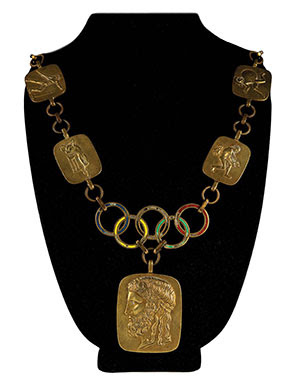 Also, garnering significant attention is the winner's medal awarded to Cuban boxer Orlando Martinez for his triumph in the bantamweight boxing event at the Munich 1972 Summer Olympics. This gilt silver medal, designed by Gerhard Marcks and manufactured by the Bavarian Mint, showcases a unique reverse design featuring the mythological twins Castor and Pollux. With its original golden chain and engraving indicating the winner's event, Martinez's victory medal is an appealing and captivating piece of Olympic history (Estimate: $10,000+).
Also, garnering significant attention is the winner's medal awarded to Cuban boxer Orlando Martinez for his triumph in the bantamweight boxing event at the Munich 1972 Summer Olympics. This gilt silver medal, designed by Gerhard Marcks and manufactured by the Bavarian Mint, showcases a unique reverse design featuring the mythological twins Castor and Pollux. With its original golden chain and engraving indicating the winner's event, Martinez's victory medal is an appealing and captivating piece of Olympic history (Estimate: $10,000+).
One of the standout treasures in this auction is the rare Lake Placid 1980 gold medal awarded to legendary figure skater Alexander Zaitsev. Crafted in gilt silver by Tiffany and Co., this exceptional medal boasts a captivating design featuring a raised hand holding the Olympic torch against a mountain backdrop. With its scarce mintage of only 73 gold medals awarded at the Lake Placid 1980 Winter Olympics, this particular example holds immense desirability and rarity (Estimate: $75,000+).
The auction also features a scarce unawarded winner's medal issued for the Seoul 1988 Summer Olympics. Crafted in gilt silver by the Korea Security Printing and Minting Corporation, this medal showcases a sleek modern design on the reverse, portraying a soaring dove of peace with a laurel branch. Complete with its original ribbon and presentation case, this medal represents a highly sought-after collectible for Olympic enthusiasts (Estimate: $15,000+).
Additionally, the auction offers an array of other noteworthy items, including a winner's medal issued for the Athens 1896 Olympics, a unique IOC 'Chain of Honour' issued for the Berlin 1936 Summer Olympics, and an extraordinary selection of tickets, souvenirs, and other significant Olympic memorabilia.
The RR Auction Olympic Memorabilia sale will conclude on July 20. To explore the full catalog and for further information, please visit www.rrauction.com.
To read the complete article, see:
RR Auction's Olympic Sale featuring items from 1896 to 2022 winter games now underway
(https://artdaily.cc/news/159289/RR-Auction-s-Olympic-Sale-featuring-items-from-1896-to-2022-winter-games-now-underway)
NUMISMATIC NUGGETS: JULY 16, 2023
Here's a selection of interesting or unusual items I came across in the marketplace this week. Tell us what you think of some of these. -Editor
The Telford Premium Medal
The Portland Collection, Commemorative Medals, Engineering: Bridges, Thomas Telford, the Telford Premium medal, struck in gold, of the Institute of Civil Engineers, instituted 1835, by J. S. & A. B. Wyon after William Wyon, awarded 1919-1920.
Bust of Thomas Telford l., rev. view of the Menai suspension bridge, shipping below on the Menai Straits, edge named, ‘JOHN KERR ROBERTSON, M. INST. C. E.', wt. 113.91gms.; 57.5mm. (BHM.1328; Eimer 1206), a superb medal, certified and graded by NGC as Mint State 63 (NGC 5878352-003).
Thomas Telford (1757-1834), FRS, FRSE, Scottish civil engineer, architect and road, bridge and canal builder.
Lt-Col. John Kerr Robertson (1878-1962) served his apprenticeship under Messrs Forman and McCall from 1896-1901. He worked on railways before, in 1902, becoming Assistant Engineer to the Clyde Navigation Trust. In 1904 he was appointed Assistant Engineer to the Railway Department of the Government of India, working there until 1914 when he moved to the Uganda Railways. In 1915 he received a temporary Commission as a Captain in the Royal Engineers, serving in the Adriatic, and Baltic Provinces. He remained in the army up to 1921 with, by then, the rank of Lt-Colonel. After receiving the medal, he continued his work on many overseas projects including Kenya, India and the Haifa-Baghdad Railway harbour works in Turkey.
Last week I opened this section with a Trinity College Dublin Gold Medal. Here's another interesting gold medal from the Baldwin's basement. -Editor
To read the complete item description, see:
THE TELFORD PREMIUM MEDAL, INSTITUTE OF CIVIL ENGINEERS, GOLD PRIZE MEDAL 1919/20
(https://www.baldwin.co.uk/product/the-telford-premium-medal-institute-of-civil-engineers-gold-prize-medal-1919-20/)
John Milton Medal
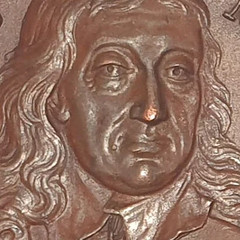 John Milton, AE Medal c. 1740 by J. Dassier (MI I 564/229; Eimer 254). Good Very Fine, some cabinet friction.
John Milton, AE Medal c. 1740 by J. Dassier (MI I 564/229; Eimer 254). Good Very Fine, some cabinet friction.
Another medal from the Baldwin's basement. A coppery rub on Milton's nose. -Editor
To read the complete item description, see:
JOHN MILTON, AE MEDAL C. 1740 BY J. DASSIER
(https://www.baldwin.co.uk/product/john-milton-ae-medal-c-1740-by-j-dassier/)
1928 Romanian Agriculture Medal
Lot 138: Medal, "Higher School of Agriculture Herastrau-Bucharest",
engraver Jeni Szirmai, 1928
A10 by Artmark
Bucuresti, Romania
I guess I'm on a medal kick this week. Here's an unsold lot from a July 14th sale. -Editor
To read the complete lot description, see:
Lot 138: Medal, "Higher School of Agriculture Herastrau-Bucharest", engraver Jeni Szirmai, 1928
(https://www.invaluable.com/auction-lot/Medal,-Higher-School-of-Agriculture-Her-str-u-Bu-138-c-395475ABB4)
THE BOOK BAZARRE
MORE ON THE GREAT KENTUCKY HOARD
We mentioned this first in my Baltimore show diary where I spoke with Jeff Garrett about it, but now that the marketing machine is kicking in, the story is popping up everywhere with some great new images and a short video. Jim Haas passed along this New York Post article about the Great Kentucky Hoard
. Thanks.
-Editor
A man in Kentucky hit the jackpot after he discovered over 700 coins from the Civil War era on his rural farm.
The findings have been nicknamed the Great Kentucky Hoard
and include a group of 1863 Double Eagles and hundreds of US gold dollars dated from 1850 to 1862, as well as a few silver coins, per Numismatic Guaranty Company, which certified the pieces.
In a YouTube video posted by GovMint, one of the biggest collectible coin marketers in the United States, the unidentified man is seen digging up the pieces of treasure — potentially worth millions — from the dirt.
This is the most insane thing ever,
he said. These are all $1 gold coins, $20 gold coins, $10 gold coins and, look, I'm still diggin' them out.
Ninety-five percent of the coins found are gold dollars, per GovMint. Also included are around 20 $10 Liberty coins from 1840 to 1862 and about eight $20 Liberty coins from 1857 to 1862.
Some of the rarest coins that they found, 1863-P $20 Gold Liberty coins, can command a six-figure price,
according to GovMint. And they dug up 18 of them in the bounty.
While I'm always excited when someone calls asking for advice about a rare coin discovery, the opportunity to handle the Great Kentucky Hoard is one of the highlights of my career,
said Jeff Garrett, a rare coin dealer.
The importance of this discovery cannot be overstated, as the stunning number of over 700 gold dollars represents a virtual time capsule of Civil War-era coinage, including coins from the elusive Dahlonega Mint. Finding one mint condition 1863 Double Eagle would be an important numismatic event,
he continued.
Finding nearly a roll of superb examples is hard to comprehend.
To watch the video, see:
Watch the video to see and hear the reaction of the person who discovered the Great Kentucky Hoard.
(https://www.govmint.com/great-kentucky-hoard)
To read the complete article, see:
Man discovers 700 Civil War coins worth millions buried at Kentucky farm
(https://nypost.com/2023/07/11/man-discovers-700-civil-war-coins-worth-millions-buried-at-kentucky-farm/)
Thanks also to Richard Miranda, Paul Horner, Howard Engel, Heath White, and Leon Saryan. -Editor
To read some of the other articles, see:
Kentucky man finds over 700 Civil War-era coins buried in his cornfield
(https://www.yahoo.com/lifestyle/kentucky-man-finds-over-700-090000279.html)
Man uncovers more than 700 gold coins on his cornfield: 'Most insane thing ever'
(https://nationalpost.com/news/man-uncovers-more-than-700-gold-coins-on-his-cornfield-most-insane-thing-ever)
Kentucky man finds over 700 Civil War-era coins buried in his cornfield
(https://www.livescience.com/archaeology/kentucky-man-finds-over-700-civil-war-era-coins-buried-in-his-cornfield)
Hoard of 700 Civil War-era gold coins unearthed in Kentucky cornfield, collectors say
(https://www.msn.com/en-us/money/markets/hoard-of-700-civil-war-era-gold-coins-unearthed-in-kentucky-cornfield-collectors-say/ar-AA1dPMNm)
Hundreds of Civil War era gold coins found in Kentucky farm. ‘Most insane thing ever'
(https://www.kentucky.com/news/state/kentucky/article277238253.html)
To read the earlier E-Sylum articles, see:
WAYNE'S NUMISMATIC DIARY: JUNE 11, 2023
(https://www.coinbooks.org/v26/esylum_v26n24a24.html)
THE GREAT KENTUCKY HOARD
(https://www.coinbooks.org/v26/esylum_v26n25a18.html)
THE TRINITY COLLEGE DUBLIN GOLD MEDAL
Last week I pictured a Trinity College Dublin gold medal I'd come across online. -Editor
Ronan Fitzpatrick of the Numismatic Society of Ireland writes:
"For the first Occasional Papers that I edited for the Numismatic Society of Ireland I wrote up Ernest Alton's four Trinity College Dublin gold medals and published it as Paper 42 in 2008."
Ronan kindly forwarded a copy of the paper, and with permission, here are some excerpts. Thank you! -Editor
A lack of gold pieces in the Irish coin series means that collectors who wish to include gold in their Irish collections have to rely on medals. Here too, their efforts can be frustrated since gold pieces are not often offered for sale. Irish gold medals have been struck for agriculture, religion, politics, the services, sport, and significantly for academic achievement and contribution. In his account of Irish medals Dr. A. E. J. Went explains that Trinity College Dublin (TCD) are the leaders of Irish Universities when it comes to the number of medals it has awarded (Went, 1978). Numbered amongst the College's extensive list of prizes and other awards are details of their medals which include accounts of gold medals (Calendar, 2005-06). This paper presents an account of the gold medals awarded to one student at the College. It also provides a brief account of the later career of the recipient.
Ernest Henry Alton was born at Marlinstown, near Mullingar in Ireland on 21 September 1873. He was admitted as a classics student to Trinity College Dublin in 1894, graduated B.A. 1896, M.A. 1899 and Litt.D. in 1928 (Clarke, 2005). Ernest Henry Alton was awarded four gold medals by the University for his academic achievements. The awards were the Vice-Chancellor medal for Latin, the Bishop Berkeley medal for Greek, the Wray medal for Logics and Ethics, and the Vice-Chancellor medal for Classics in Greek or Latin prose (the medal reads Humanities). The first two of these medals are competed for by students in the Senior Freshman or the Junior Sophister years. The third and fourth medals are prizemen awards for achievement in the degree examinations.
Ernest Henry Alton became a Fellow of Trinity College Dublin in 1905. He was Captain of the University Officer Training Corp (OTC) and during the Easter Rising of 1916 he was in command of the Trinity Garrison. The Garrison secured the College during Easter Week 1916 and by their actions the OTC gained the unique distinction of being the only Corp to actually defend its University (Willoughby, 1989). Ernest Henry Alton was elected as representative of the University to the second Dáil Éireann in 1921 and was re-elected on six further occasions, serving continuously from 1921 until 1937. He also served in Seanad Éireann from 1938 to 1943. From 1927 to 1942 he was Professor of Latin and was Vice-Provost of the University from 1941 to 1942. Professor Alton was admitted as Provost of Trinity College Dublin on 13 May 1942. He died at Provost's House in the College on 18 February 1952 in his 79th year.
In October 2004 the four gold medals of Ernestus H. Alton were offered for sale on the Internet by Fort Lauderdale Rare Coins (FLRC) of Florida, USA. The group, which had remained together for over 100 years, unfortunately was divided with the medals being purchased by three different collectors. Fortunately, the collectors are known to each other.
The descriptions of the medals are based on those of FLRC as originally described at their website and on descriptions of similar medals in Spink's Numismatic Circular. Specific details of each medal have been provided by the medal owners and their clarification of those details is acknowledged by these lines. Photographs are courtesy of Fort Lauderdale Rare Coins, Florida, USA. Assistance and advice provided by the Library staff and Patrick Wyse Jackson at Trinity College are also acknowledged.
For more information on the Numismatic Society of Ireland, see:
https://www.numismaticsocietyofireland.com/
To read the earlier E-Sylum article, see:
NUMISMATIC NUGGETS: JULY 9, 2023 : Trinity College Dublin Gold Medal
(https://www.coinbooks.org/v26/esylum_v26n28a23.html)
CONSPICUOUS GALLANTRY CROSS OFFERED
The Conspicuous Gallantry Cross (CGC) is an important U.K. military medal that is often overshadowed in the media by the Victoria Cross. Here's an article about the sale of CGC. -Editor
An Afghan veteran and former Royal Marine is set to sell a medal he earned for bravery in London later this month in a bid to help fund a retreat for soldiers in the Scottish Highlands.
The Conspicuous Gallantry Cross (CGC) was presented to Brad ‘Bugsy' Malone when he was part of the elite 45 Commando Royal Marines. Only 60 soldiers have ever received the rare honour.
Bugsy earned the medal for his fighting prowess and gallantry
shown during three separate incidents in Helmand Province in 2008. The first, when his troop was ambushed by insurgents, he ordered his comrades to bayonet-charge the enemy who fled in terror.
On a second occasion, he scrambled from the cover of a ditch and dodged a hail of Taliban bullets as he ran to help his Sergeant, who had been isolated from his troop whilst firing mortars on the enemy. Fighting together, the pair managed to hold off the insurgents and reach safety.
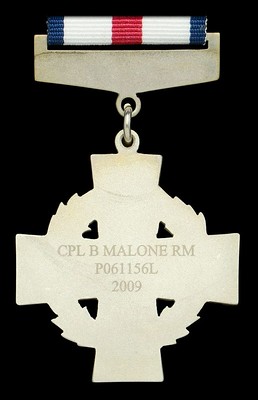 In the third act of bravery, on December 31, 2008, Malone fired more than 900 rounds from his machine gun as he kept the enemy at bay for an hour, whilst casualties from an explosion which killed his section commander were evacuated.
In the third act of bravery, on December 31, 2008, Malone fired more than 900 rounds from his machine gun as he kept the enemy at bay for an hour, whilst casualties from an explosion which killed his section commander were evacuated.
It is estimated the medal will fetch between £100,000 and £140,000 at auction in London later this month.
When he was invested with the C.G.C at Buckingham Palace in 2009, Malone chose the auspicious day to successfully propose to his girlfriend.
The 37-year-old left the Royal Marines after 16 years in 2018 and now wants to build a retreat in the Scottish Highlands for like-minded soldiers to use and experience a new way of life.
To read the complete article, see:
Veteran selling gallantry medal at London auction to fund soldiers' retreat in Highlands
(https://www.mylondon.news/news/uk-world-news/veteran-selling-gallantry-medal-london-27256025)
LIMERICK SOVIET BANK NOTE FOUND
A rare and interesting note has been found in the archives of the Bank of Ireland. Found via News & Notes from the Society of Paper Money Collectors (Volume IX, Number 3, July 4, 2023). -Editor
A BANK note from the days of the Limerick Soviet has been uncovered during a review of archive material in one of Ireland's oldest banks.
As part of its 240th anniversary celebrations, Bank of Ireland has been conducting a review of its archive materials, and found among them an uncirculated Limerick Soviet bank note dating from 1919.
After a protest against military actions, a state of martial law was imposed on Limerick, bringing the city and county under military rule, closing the routes to Limerick and cutting off the access of about 5,000 workers to their employment unless they had been issued a British military pass.
As a response to this, a strike was called by the Limerick Trades and Labour Council, a protest against the British Army's declaration of a ‘special military area' around Limerick.
Refusing to use British Military passes and instead printing their own, the Limerick Soviet also set up committees to organise the distribution of food, fuel, and the general running of the city.
The bank note that was found in the Bank of Ireland archives was for the value of one shilling and is dated April 1919.
To read the complete article, see:
Rare Limerick Soviet bank note found among bank's archives
(https://www.limerickpost.ie/2023/06/28/rare-limerick-soviet-bank-note-found-among-banks-archives/)
MARCEL DUCHAMP'S MONTE CARLO BOND
We've discusses this money-themed artwork before - Marcel Duchamp's Monte Carlo Bond. Here's a new article from the MIT Press Reader. Also found via News & Notes from the Society of Paper Money Collectors (Volume IX, Number 3, July 4, 2023). -Editor
What was one of the most radical artists of the 20th century doing playing roulette in the casinos of Monte Carlo? And why did he insist, as he honed his complex gambling system, armed with capital from a risky financial scheme, that I haven't stopped being a painter, now I draw on chance
? This article is drawn from my book on the importance of the poet Stéphane Mallarmé for debates among European avant-garde artists about chance, the nature of language, and the hazards of communication. While the full chapter argues that Duchamp had Mallarmé's impossible dream of abolishing chance
in mind as he confronted the incipient financialization of art, this excerpt lays out Duchamp's strategy to break the bank in Monte Carlo and his quixotic hope to render roulette into a game of chess.
On November 1, 1924, Marcel Duchamp issued his Monte Carlo Bond, a limited-edition artwork and bearer bond (obligation au porteur
as it is written on the front of the work), which is to say, a legal agreement that could be traded and spent like paper money.
As though advertising its split identity, the bond identified Duchamp's female alter ego, Rrose Sélavy, as the President of the Administrative Council
and relegated him to the role of her Administrator.
The reverse of the bond provided the statues of Sélavy's joint-stock company and some basic information about its aims: The goal of the company is… Exploitation of Roulette in Monte Carlo under the conditions listed below… The annual payment is based upon a cumulative system [système à montant], experimentally tested through 100,000 rolls of the ball, which is exclusive property of the Administrative Council.
The stated purpose of its production and sale was to raise capital to fund Duchamp's deployment of his roulette system.
He initially intended to sell 30 Monte Carlo Bonds, but it seems that only eight were produced — and even fewer sold. The nature of the sale,
what it meant to purchase one of the works, was one of its greatest paradoxes: On the one hand, it was a limited-edition print and artwork; on the other, it was made, quite seriously it seems, as a bearer bond, a financial instrument entitling its purchaser to be paid interest on their investment at a rate of 20 percent.
These two modes entail radically different aesthetic, economic, and power relations between buyer and seller, yet they were fused in this one object, in which the artist was both source of aesthetic value and debtor, and the buyer was both collector and creditor. Whether conceived as a critique of the art market or as a shrewd financial arrangement, Duchamp's Bond appears extraordinary prescient from the vantage point of the 21st century, when debt drives the financialization of social relations and works of art are sheltered from their public value (as objects made to be beheld or as taxable assets) in Freeport storage vaults, to be glimpsed only at the moment of exchange.
Man Ray, who visited Duchamp in Nice and accompanied him to the casinos on at least one occasion, ... recalled that Duchamp studied the monthly sheets of all the numbers that came up, published by Monte Carlo, and worked out a system of placing his money that would infallibly bring in a return profit.
And, later, Duchamp specified that he was exploiting a Martingale to break the bank in Monte Carlo,
but continued: Unfortunately, the system is too slow to have a practical value. I often had to wait over half an hour for the numbers to appear in the succession of reds and blacks and the weeks I spent in Monte Carlo were so boring that I soon abandoned it, happy to emerge without a loss.
Duchamp's art was far more successful than his foray into gambling - in 2010 Christie's sold one of these works for over $1 million. -Editor
To read the complete article, see:
Marcel Duchamp, the Gambler
(https://thereader.mitpress.mit.edu/marcel-duchamp-the-gambler/)
To read the earlier E-Sylum article, see:
MARCEL DUCHAMP'S MONTE CARLO BOND NO 1
(https://www.coinbooks.org/esylum_v14n05a20.html)
WALL STREET'S CRYPTO ARTIST
(https://www.coinbooks.org/v24/esylum_v24n22a24.html)
LOOSE CHANGE: JULY 16, 2023
Here are some additional items in the media this week that may be of interest. -Editor
A short PCGS article by Joshua McMorrow-Hernandez examines the stories behind a few coin variety names. Here's one I hadn't heard of yet. -Editor
There's a wide variety of terms in the world of coin collecting that catch some people off guard. Surely, there's the array of technical-sounding nomenclature, like doubled die, counting machine mark, mottled toning, and transitional issue – all terms, by the way, that are explained on PCGS Lingo Full Listing. Then there are phrases such as Speared Bison Nickel, Bugs Bunny Half Dollar, and Hot Lips Dollar that are so comical in nature that it might make some wonder if a witty jokester discovered these popular (if funnily named) variety coins.
2005-D Speared Bison Nickel
The Westward Journey Nickel series that was struck from 2004 through 2005 and launched a series of four special designs honoring the 200th anniversary of the Lewis and Clark Expedition created at least one notable variety. The 2005-D Speared Bison variety features a significant die crack that formed a raised line that resembles a spike protruding through the back of the bison. The 2005-D Speared Bison Nickel is not just popular, but it's also quite scarce, resulting in robust prices for this coin even in circulated grades, where values hover above $50 – Mint State specimens generally cost over $150.
To read the complete article, see:
Where Did That Coin Variety Name Come From?
(https://www.pcgs.com/news/where-did-that-coin-variety-name-come-from)
Speaking of Loose Change, Richard Miranda passed along this story of an armored truck crash in Lansing, MI. Thanks. -Editor
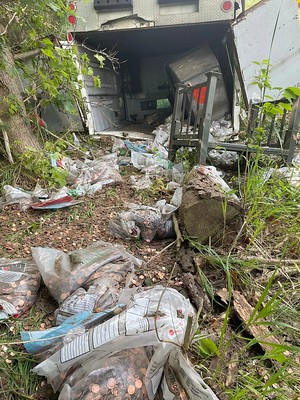 A Loomis armored truck crashed and spilled bags of coins Wednesday afternoon on eastbound Interstate 96 near Waverly Road, the Michigan State Police said in an online post.
A Loomis armored truck crashed and spilled bags of coins Wednesday afternoon on eastbound Interstate 96 near Waverly Road, the Michigan State Police said in an online post.
The Loomis truck was unable to stop in time for a traffic backup about noon, MSP said in the post.
The truck struck a vehicle, the driver then lost control and the vehicle overturned off the side of the highway. The rear doors of the vehicle opened and bags of coins spilled onto the ground, photos of the scene show.
The occupants of the truck suffered minor injuries. The driver of the other vehicle was not injured.
To read the complete article, see:
Armored truck spills coins after highway crash south of Lansing
(https://www.yahoo.com/news/armored-truck-spills-coins-highway-112427274.html)
Arthur Shippee passed along this Yale Alumni Magazine article about Treasurer of the United States Marilynn Malerba. Thanks. -Editor
Soon after completing the DNP program, Malerba became increasingly involved in national tribal policies as a member of federal advisory committees, including a treasury department committee about tribal taxation and finances. Tasked with the challenge of representing the interests of more than 500 federally recognized tribes, Malerba found herself again hosting listening sessions to hear the diverse issues tribes were facing all over the nation.
Then, the most startling request of all: the White House called to ask if she would serve as treasurer of the United States. Once more, Malerba had to choose between advocating for her own people or making an impact on a larger scale. But the choice was obvious to her local community. They'd miss her—but the advantage of having her working at the federal level for Indigenous people was clear. Knowing that you're sending your best is always really very comforting,
says Zobel, who has known Malerba for decades. The Council of Elders gave their blessing, paving the way for Malerba to become a history-making Native American chief serving in the US government.
Moss, now a professor of nursing at the University of British Columbia, was thrilled when she learned about Malerba's appointment. I just thought, ‘This is brilliant,'
she says. Mary Ann Camilleri, program director of the doctor of nursing practice program, says she is overjoyed that an alumna of the was making history: One of our graduates has really broken through a major glass ceiling.
Moreover, Malerba will also oversee a new tribal affairs office within the treasury. She's so uniquely qualified,
Camilleri notes, that the position has evolved to meet her qualifications.
On September 12, at her historic swearing-in ceremony, Malerba wore bright red regalia as she stood beside Janet Yellen '71PhD, secretary of the treasury. The regalia, a gift from the Mohegan tribe when she was named chief in 2010, had been handmade by local beaders. Zobel and other members of the Mohegan tribe eagerly watched the live-stream online—several times, she admits.
To read the complete article, see:
Decisions of the heart
(https://yalealumnimagazine.org/articles/5701-decisions-of-the-heart)


